The post Espas Sakre first appeared on The Belgo Report.
]]>November 9 – December 21
Espas Sakre was Desvarieux’s first solo exhibition at Galerie Hugues Charbonneau where he is newly represented. The show was part of the Pictura triennial of Montreal painting. Here he pays homage to his many influences and shares what he has learned about painting since he began making art in 2013. The works here show a rapid progression and integration of many aesthetic interests including Modern Art, Abstract Expressionism, and Haitian art, exploring a full spectrum of figuration and abstraction in mostly large acrylic paintings. Desvarieux is an omnivorous painter, synthesizing fragments of Basquiat, de Kooning, Picasso, Hilma af Klimt, Peter Doig, and others, but rather than becoming derivative, he has been expanding his personal range. These works are idealistic, energetic, and holy. They depict a paradisiacal vision of the Haiti of the artist’s hopes and dreams. Many of the interpretations that follow are extracted from an interview I did with the artist in the gallery in December 2023.
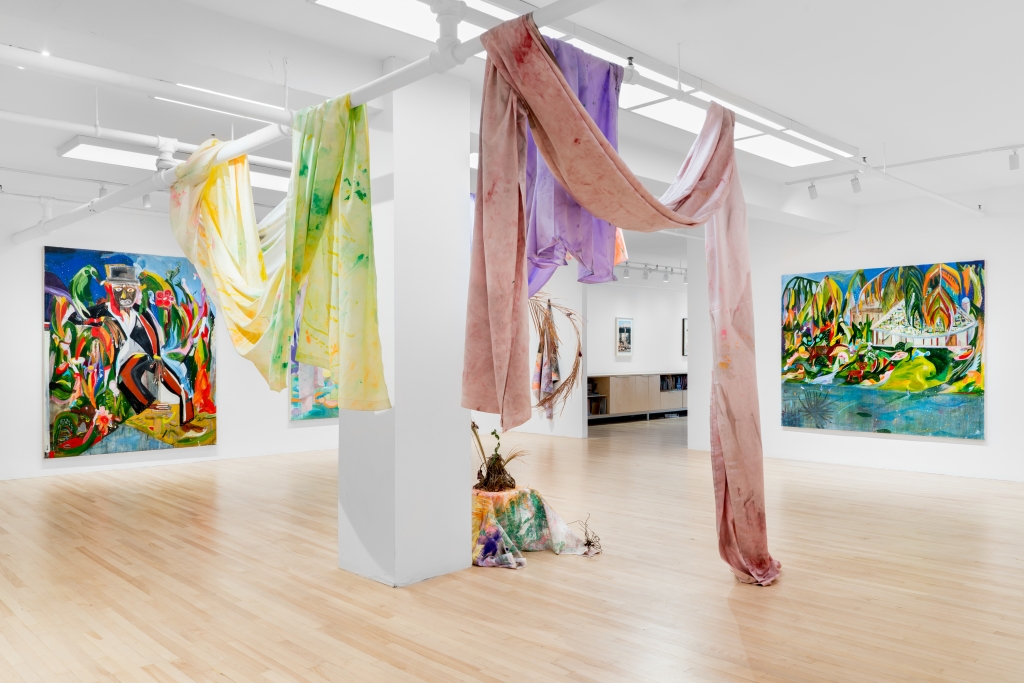
installation view
What is immediately apparent is Desvarieux’s sense of colour and form, his painterly virtuosity, his sophisticated sense of rhythm, his references, and his very apparent love of creating. In many ways, he is a painter’s painter. Going deeper however, there are cultural mythologies being shared, spirits being invoked, and new ways of existing being called forth. Desvarieux said “Haiti is Vodou”, and that Vodou is in the gastronomy of Haiti, the land, the language, and much of the music. I was told that all of the elements and all of nature are understood to be loa, spirits or deities. This animism gives practitioners of Vodou—of which there are still many in Haiti—a great reverence for the land and for the spirits they work with and for. Desvarieux learned about Vodou, his culture, his upbringing, and his ancestry through researching what was available to non-initiates and applying what he found to his painting.
Desvarieux was born in Port-au-Prince and has been living in Montreal for many years. He comes from a political Haitian family who were art collectors, so he grew up surrounded by paintings and the works of many celebrated Haitian artists. Desvarieux came to Montreal to complete his education and discovered his true path was in making art. He is the co-founder of Montreal art collective Atelier Good People, and besides being a painter and community leader he is also a photographer. I first saw his work in person in a group show at Galerie Hugues Charbonneau, Imaginaires souverains, in 2022, and then again in a duo show in 2023 called Le langage secret de l’univers at Maison de la Culture Claude-Léveillée, Montréal. Desvarieux has also shown recently at Sargent’s Daughters in Los Angeles and at the Musée des Beaux-Arts Montreal. His painting has been rapidly progressing in very interesting ways, and with this solo show, it is clear that his work has gained enough strength to show that he is a formidable painter.
Those who are familiar with the history of Haitian art might recognize in his influences most notably Andre Pierre and Hector Hyppolite, Vodou priests who painted scenes of Vodou who painted the loa often. The landscapes of Haiti with heavy tropical foliage, bustling with energy and life, and scenes of Vodou religious rites and loa are evoked in Desvarieux’s works such as Ogou Fè and Legba Mèt Lakou as they are in the work of Pierre. They are intrinsically Haitian with their reverence for the land, the loa, and the ideals they convey.
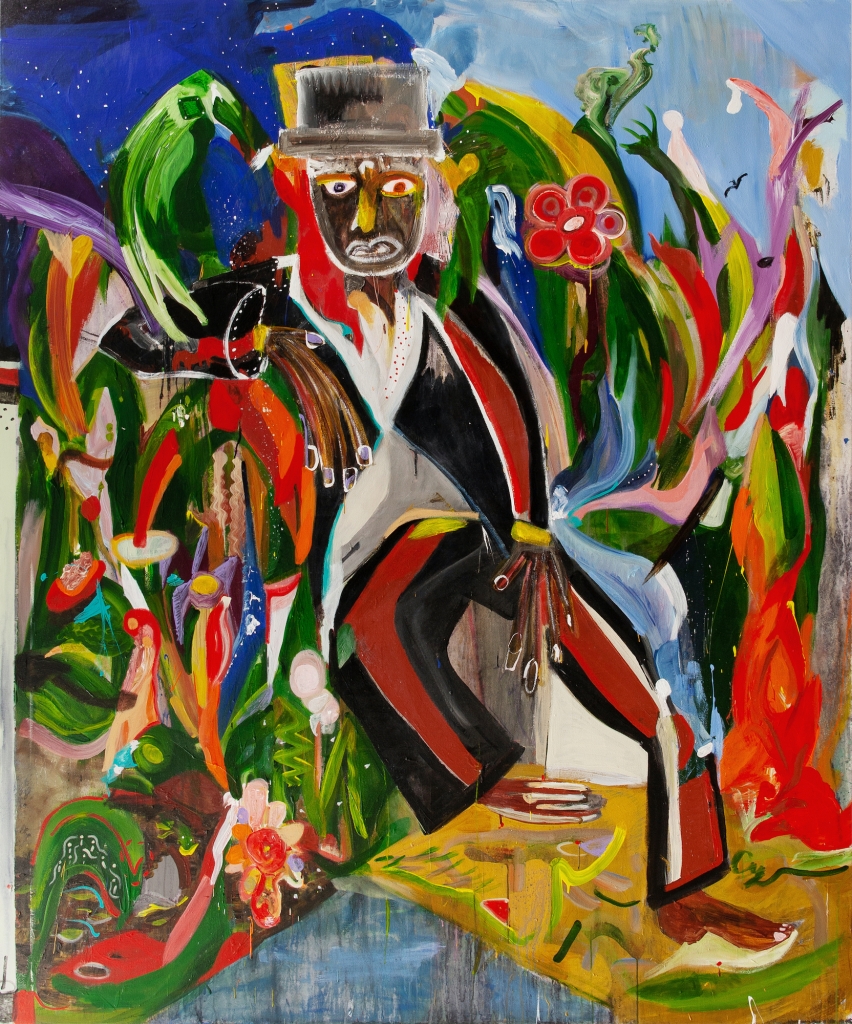
Legba Mèt Lakou
Desvarieux’s art practice is deeply spiritual and pulls strongly on his experience of being raised surrounded by Vodou. His process is ritualistic, intuitive, and reverent. Loa Legba greeted us at the beginning of the exhibition—you had to pass by him to go further—he stood at the crossroads between the outside world and the sacred space created for us. Legba Mèt Lakou shows Papa Legba of the crossroads, a trickster God who Desvarieux has painted many times. In Vodou you cannot do magic without Papa Legba. He is a deity of the arts, loa of writers, painters, and he dwells in the in-between spaces where invisible becomes visible. This is also the domain of art. Here Papa Legba, wearing a suit of red and black, sits casually in nature and it seems as if dusk is coming on and some stars are visible. He is surrounded by the lush tropical flora of Haiti by the edge of the land and water. Legba seems as if he was waiting for you, but he is in no sort of hurry. His eyes meet yours, his large hands dangle at rest, he seems to accept you, as if he may let you pass. Those familiar with the history of art will see in this painting touches of Cubism, of Basquiat, of de Kooning. Painters will admire the complex but harmonious layering in this large canvas.
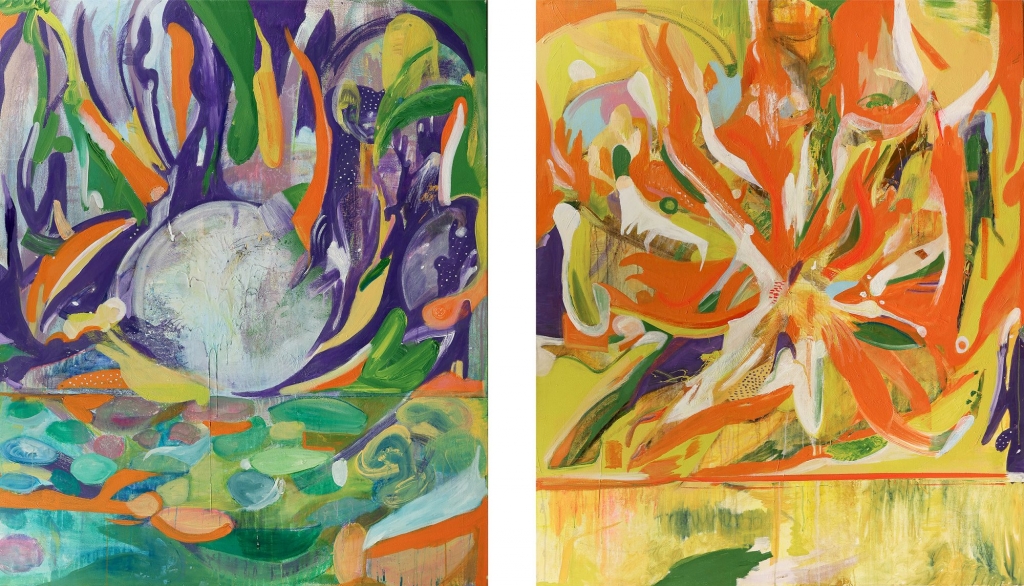
Marasa
The next paintings are a diptych, two panels placed close beside each other, titled Marasa, they seem to reference the moon and the sun, respectively. The left panel has a grey disk rising over tropical waters with heavy plants surrounding the view, it is done mostly in cool purples and greens, a self-contained lunar scene. On the right panel, we find warm tones, solar tendrils, an expansive energy above a simple horizon line, a land in summer bleached by the hot sun, or a giant orange lily blooming in the equatorial heat. In Tantra, the left is feminine and lunar, while the right is masculine and solar. In many traditions the left hand path is considered dark, and the right is associated with light. These two panels call to mind Yin and Yang, divine feminine and divine masculine, and the harmony of opposites. Desvarieux told me that to create this diptych, he had a process that is rooted in the meaning of the painting itself. He gessoed two canvases, stuck them together, and once they began to dry, he ripped them apart, and with a resoundingly loud crack, one became two. I enjoyed hearing how his process was ritualistic, as if the painting itself is initiating some magical process which echoes the creative energies of the universe. In Vodou, Marasa are the sacred twins, road openers, the guardians of the threshold who it is necessary to invoke after Legba before proceeding with the ritual. Esoterically the first emanation of life is where one becomes two, and Desvarieux said that he wanted to make a gesture which represents that divide, likening it to splitting the atom. In the mythology of Plato’s Symposium, humans were created with four arms, four legs, two sets of sexual organs, and a single head with two faces. These early human beings were thought to be powerful, whole, and physically perfect. The Gods felt threatened by these strange creatures and Zeus divided them, splitting the unit into two, leaving the pair forever fated to seek union with their other half, thus creating some of the modern lore of soulmates which persists to this day.
Hanging throughout the gallery were hand-dyed fabrics in purples, yellows, greens, and pinks which were sometimes one whole colour, sometimes fading from one to another, and splotched throughout. The colours and patterns mimicked the dance of vibrations in the canvases below. They both accentuated and sheltered the works, and created a sacred space within the sacred space for the small natural altar at the centre of the gallery. It was a humble ephemeral altar which paid tribute to the two lands on which Desvarieux has lived, palm for Haiti and sweetgrass for Canada. The effect of the hangings made the exhibition feel a little bit like it was on a stage. He said that Haitian Vodou is theatrical, it is both serious and joyous with a lot of ornaments, smells, food, and music. Coloured fabrics are also used in Vodou rituals to signify different loa.
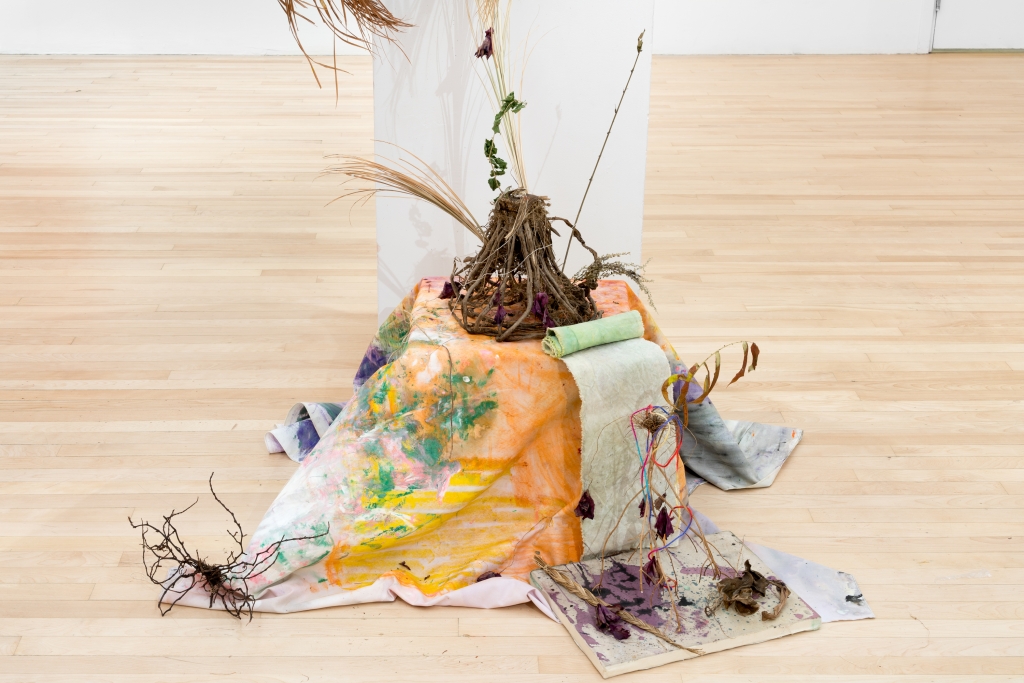
ephemeral altar, closeup view
Lakou lanmou I is a pastoral which pays tribute to indigenous, green, and sustainable architecture. We see a dirt or mud house with leaves for roof amid a colourful and lush paradise at the edge of the sea. There is a horned mythological creature on the coast and the water before it feels deep, luminous, and alive. This Arcadia which shows a sacred space existing in harmony with nature. Lakou in Haitian Creole means a courtyard, a natural setting in a communal dwelling place, while lanmou means love. It is a representation of an idyllic pastoral setting, a realm that seems peaceful, lush, and safe. You can see the influence of Peter Doig in this work, particularly in the water and the palm trees. Doig is also an artist with deep connections to both the Caribbean and Canada, and his big survey exhibition at the Montreal Museum of Fine Arts in 2014 would have been not long after Desvarieux started painting.
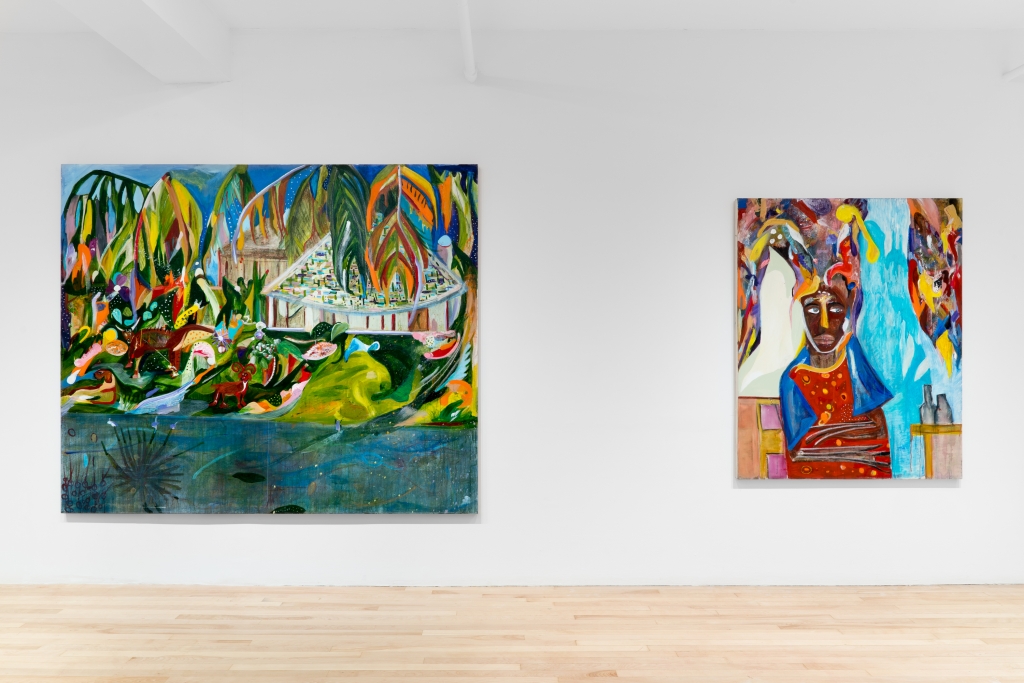
Lakou lanmou I and Autoportrait dans la zone des ombres colorées
Desvarieux spoke of what is happening in Haiti right now, of the fact that Catholic and Protestant missions are still very active there in trying to stamp out Vodou. Temples have been destroyed and forests cut without respect for the land. The missions have been taking advantage of natural disasters such as the earthquake of 2010 to entrench their influence. They built schools and thus seem philanthropic but families are split apart and children are taught that their culture is evil, according to Desvarieux, the children do not even learn their own history. The shame that happened in the residential schools in Canada is happening in Haiti today. Haiti does not need help from the Church to civilize the people, without outside interference and exploitation, Haiti could thrive.
Autoportrait dans la zone des ombres colorées is a bit more personal as it depicts Desvarieux in his studio, seeming to wear as a headdress the dyed curtains that could also be seen hanging in the gallery. He said that his eye was caught by a shadow cast by a candle. He looks pensive but comfortable, and his crossed arms, just simplified white sticks, invoke Basquiat. His eyes, here painted blue, regard what seems to be a cascading waterfall. The assemblage of abstracted patterns, colours, and the turquoise water-like forms are full of movement and life, as if they could be the tumult of thoughts and feelings that move despite the stillness of the body. The self-depiction seems almost royal, the fabrics and patterns African and resplendent, but this auto-portrait is also humble and discrete. The idea of coloured shadows is familiar to artists, even in a seemingly black shadow there are subtle reflections and nuances of colour. There is an idea in Vodou philosophy that the religion contains all duality, good and evil, it accepts the polarities of life as part of the grand scheme of existence. It stands in contrast to Christianity, where evil is seen as the realm of Satan. Vodou is judged by many in the West to be an uncivilized religion based in devil worship, animal sacrifice, and curses. Yet Vodou has much in common with the complex philosophy of Eastern religions in the deep knowledge that all is One.
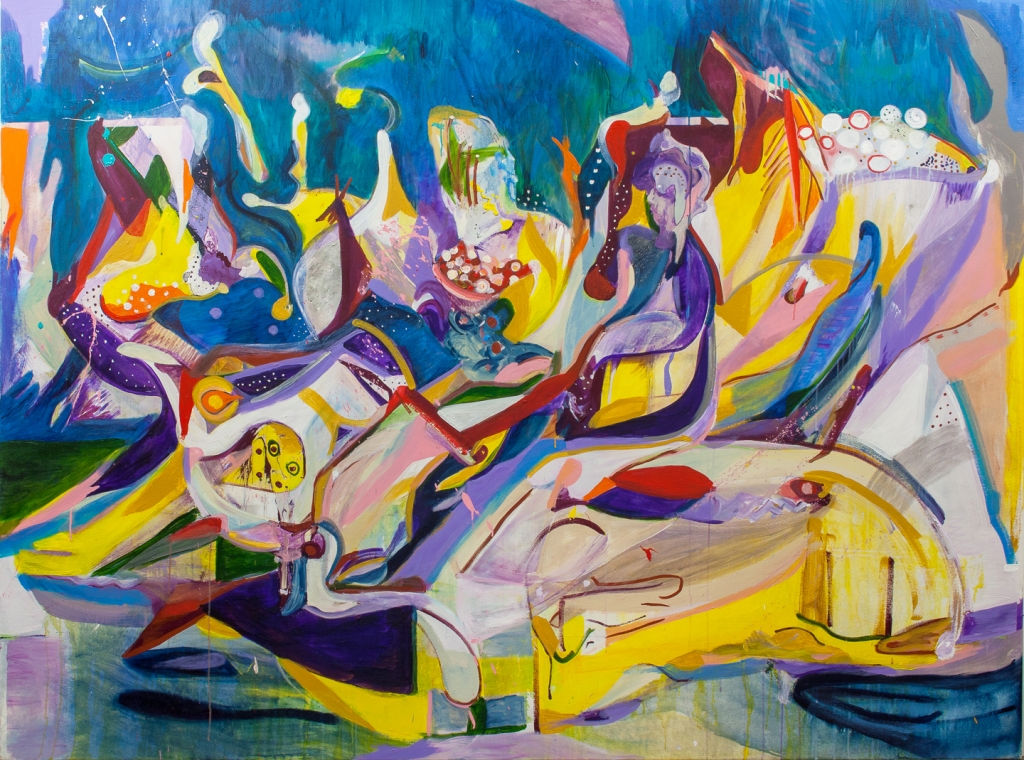
Towota Tèt Bèf
Towota Tèt Bèf is a more abstracted work, but you can see a man seated on some sort of large object, the figure makes me think a bit of Doig’s most abstracted and patterned figures. There’s more movement and rhythm to this piece than recognizable form. We find a sense of unity in the painting, almost as if between figure and ground there is little boundary. The sky is apparent with a vivid blue, while the landscape, the figure, and the bull are brought together by sunny yellow, bold purple, and various reds, along with tiny dots which often seem to signify a starry sky in Desvarieux’s works. Closer inspection reveals a bull who is be laying down with front legs extended. Desvarieux spoke of how in Haiti, a vehicle signifying status is a big Land Cruiser type of Lexus, popular with the elites and politicians. It is nicknamed tête beouf, or tèt bèf, for its size and power. The artist was also thinking of a common sight in rural Haiti, youth going to market on the back of an animal bringing things to sell. He was thinking about priorities and sustainable transportation and a slower way of life. What if being rich and powerful meant riding on the back of a bull instead of driving a tèt bèf? In Haitian culture status symbols often come from the West, ideas imposed on the culture by slavery and colonization. Picasso also comes to mind when looking at this painting, he famously used the bull as a symbol of masculine power and with his Spanish heritage it was a favourite theme. The fragmented forms in this painting show a softer sort of Cubism, and the diversity of painterly brushwork is engaging, they make you slow down to follow the artist’s hand. Desvarieux is invoking sustainable alternatives here through art as a sort of magical painting practice.
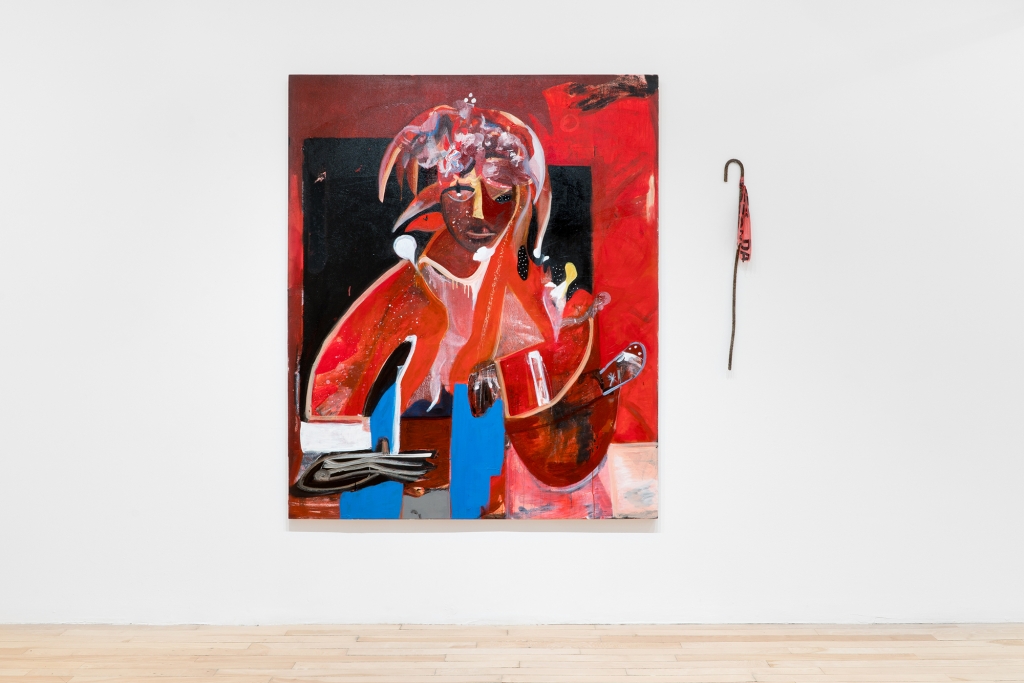
Ogou Fé
In Ogou Fé, one of the most striking works in the show, we find a figure standing out against black and red negative space in a way that evokes Francis Bacon’s work. He has dreadlocks reaching his shoulders and he seems to regard us with one eye open and one eye closed. The stars are interwoven with his body and he seems active, holding some materials, perhaps metals. He could be standing at a table with bowls, or kneeling at work with one foot kicked up, the forms are obscure and can be read multiple ways. Desvarieux was thinking about the shadow side of war. Ogou Feray is a popular Haitian Vodou loa with origins tracing back to the Yoruba in Africa. He is a blacksmith, a warrior, the Lord of War and Fire. Desvarieux said Espas Sakre was in part about drawing attention to the impact of technology on our lives—for him, the energies of fire and iron are its symbols. When humans discovered fire, we started to cook, and our brains started having different reactions from eating cooked food. From this rudimentary technology, eventually came the industrialization that has been destroying and polluting the planet, including the industry of war, and the technology that consumes our lives. When does technology stop being something that helps you and when does it start devouring you? Desvarieux said that we often live in the shadow side of this deity rather than the luminous side. The luminous side of Ogun Feray is balanced power, fertility, creation, justice. On the wall beside this painting was a found object which resonated for the artist, a metal rebar, a construction material which goes inside the concrete to reinforce a building. He found it bent like a cane and adorned with danger tape. To him, his discovery reminded him of the loa Ogun Feray. The name Feray comes from the French feraille, or scrap metal.
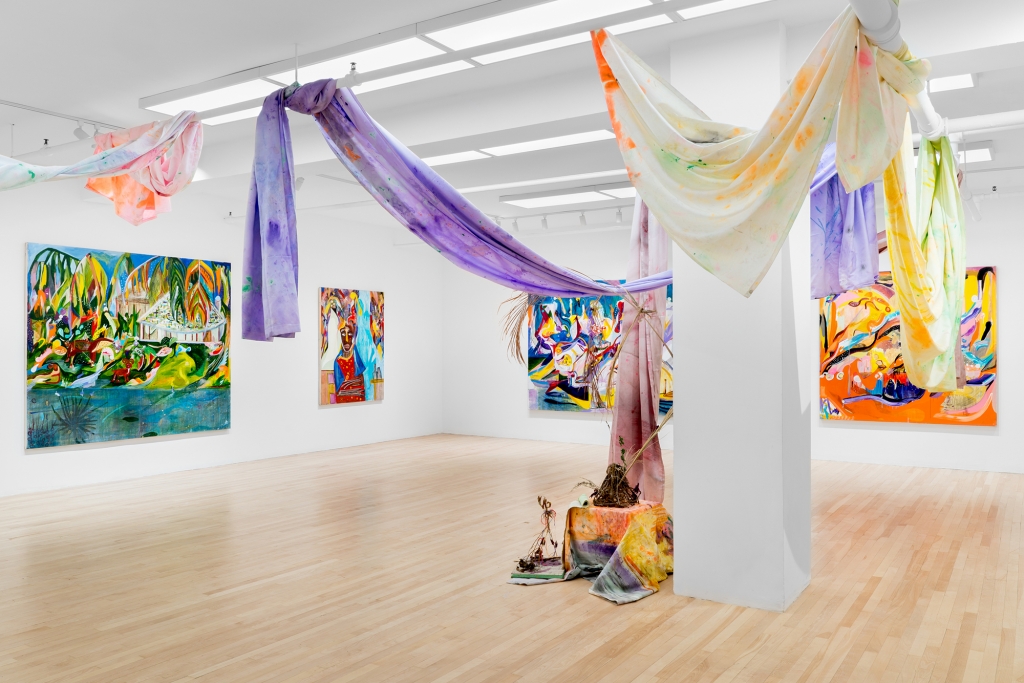
installation view
In the back of the gallery, not officially part of the exhibition, was another human sort of work, perhaps a counterpoint to the self-portrait. Titled La princesse articulée, it is a portrait of a woman regarding the viewer frankly as she enters vibrant blue water. The water is splashed up behind her in pleasing shapes. She seems to invite us to follow her, to immerse ourselves. Desvarieux says the painting is of his partner, but it is as if she has been possessed by the loa Erzulie, offering an invitation to sensuality. Her eyes are open wide and round, as if she is indeed possessed by a powerful spirit. Erzulie is a family of loa associated with love, similar to the goddess Venus or Aphrodite, and one of her colours is pink, which was used in the scarf on her head and on her dress. Erzulie is also associated with water, and one Erzulie loa—there are two—is married to Agwe, loa of the sea. Here, the woman possessed by the loa enters the water, joining her husband in unity. A major event in a Vodou ceremony is when a practitioner becomes possessed by the spirit of the loa they invoke and begin behaving as the spirit, dancing, swaying, making noises, and doing uncommon things. During this experience, the one who is possessed is said not to remember anything. Considering that the exhibition began with an invocation of Legba, the guardian of the crossroads, and Marasa, the sacred twins, this tucked away painting seemed to me to represent the conclusion of the ritual, when the spirit of the loa enters the human’s body.
Vodou is a way for initiated practitioners of the religion to have a direct experience of the divine.
It is deeply unfortunate that to this day Vodou is persecuted and maligned due to Western influence and judgement, and that Haiti has been fraught with slavery, colonization, and violence. Still, Haitians are a proud people, as they fought back against their oppressors won, liberated themselves, and then defeated Napoleon’s invading army. Vodou is rooted in Haiti as protective deities that Africans brought across the Atlantic with them during the slave trade. They had to hide their religion, ensconce it in the language and traditions of Christianity and practice in secret. Some practices were defensive magic against their oppressors. The Haitian Revolution was a slave revolt famously initiated by a Vodou high priest when practitioners performed a clandestine ceremony in the woods, and then attacked under the cover of a tropical thunderstorm, deemed an auspicious omen. It is remarkable how much of African spirituality remains intact in Haitian Vodou. Vodou is a religion that can bring healing and harmony to the people and it should be protected as an important part of the country’s cultural heritage.
Desvarieux was wrestling with the idea of creating meaning through making a sacred space within the gallery, a space that paid homage to the land, the people, and the spirits through the devotional practice of painting. Desvarieux was inspired by a quote by Carl Jung in the Red Book: “We create the meaning of events. The meaning is and always was artificial. We make it.” Jung’s idea that we make our own meaning runs parallel to the creative life of artists; the artist and the spiritual practitioner work within the realms of meaning and symbolism. The artist makes meaning in the same way that the initiate makes meaning when channeling the divine and interpreting the messages and signs. Desvarieux stresses that we do not need any fabricated structures or images in order to worship, for nature itself is the temple and the God. Artists channel from their subconscious, through their culture, through art history, through their reservoir of images, through their instincts, creating what may be significant meaning for themselves and others. But is the created object natural or artificial? Is the meaning therein any less significant for being artificial? The stories we create, the languages we construct, none of it is the thing itself. Mystics say that the divine must be experienced and cannot be understood through the mind or through books. According to Umberto Eco, “If signs can be used to tell the truth, they can also be used to lie.”
The oppression by the Catholic Church in Quebec is mostly historical, except for the indigenous here, who have not yet had justice for all the harms done to them. But in Haiti, religious oppression is still a problem. Is it risky today in often cynical and atheistic post-Catholic Quebec to make art that is so spiritual? For Desvarieux, it is a matter of courage and integrity—he says making art is for him a spiritual quest, and reception by the art world to what comes forth is a secondary concern.
Clovis-Alexandre Desvarieux’s website
Photos by Jean-Michael Seminaro.
The post Espas Sakre first appeared on The Belgo Report.
]]>The post Rentrée d’Hiver du Belgo! first appeared on The Belgo Report.
]]>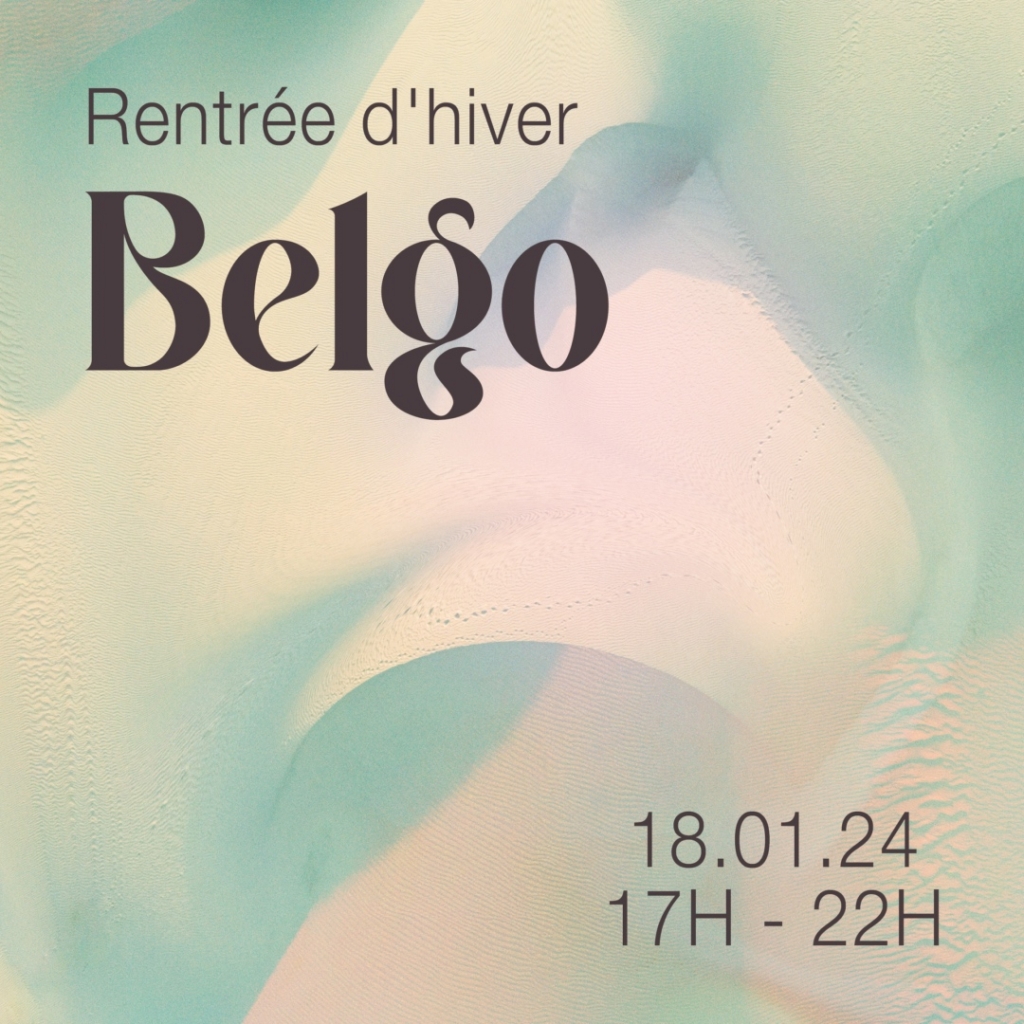
La communauté artistique du Belgo vous invite chaleureusement à sa rentrée hivernale de 2024!
De nombreuses galeries d’art, centres d’artistes, espaces d’exposition et organismes culturelles seront ouverts pour cet événement incontournable, qui rassemble une multitude d’expositions entièrement gratuites et accessibles à toutes et à tous. Plusieurs artistes exposants seront sur place, alors que nos équipes dévouées se feront un plaisir de vous accueillir dans une ambiance festive!
C’est un rendez-vous à ne pas manquer, le jeudi 18 janvier 2024 dès 17h!
— — —
The Belgo’s artistic community warmly invites you to its 2024 winter opening!
Numerous art galleries, artist centres, exhibition spaces and cultural organizations will be open for this event, bringing together a multitude of exhibitions that are entirely free and accessible to everyone. Several exhibiting artists will be present—along with the dedicated staff—to welcome you within a festive atmosphere!
An event not to be missed, Thursday January 18 from 5 p.m.!
PROGRAMMATION
314 | Centre des arts actuels Skol
Catalogue des ruines — Samuel Bernier Cormier, Lauren Chippeur, Kuh Del Rosario, Xavier Orssaud, et Elise Rasmussen
L’éponge mécanique — Ève Constantin
https://skol.ca
325 | Atelier Suárez
Atelier ouvert – Luis Fernando Suárez
instagram.com/luisfernsuarez
403 | Galerie B-312
Les galeries-logis — Pépite et Josèphe
https://galerieb312.ca
410 | Patel Brown
Susceptibility to Gravity — Alexa Kumiko Hatanaka
patelbrown.com
413 | Atelier d’art photographique
Flore — Jean-Claude Lussier
jeanclaudelussier.com
414 | McBride Contemporain
Best Friends for Never — Adrian Norvid et Marcela Szwarc
mcbridecontemporain.com
416 | Chiguer Art contemporain
Collectionner — Thierry Arcand-Bossé, Marcel Barbeau, Dan Brault, Eveline Boulva, Yves Gaucher, Pierre Gauvreau, Lise Gervais, Jacques Hurtubise, Serge Lemoyne, François Morelli, Jean-Paul Riopelle, et François Simard
chiguerartcontemporain.com
423 | Atelier Carolina Echeverría
Atelier ouvert – Carolina Echeverría
https://carolinaecheverria.ca
426 | Arprim
Cartes universelles pour voyage sédentaire — Violaine Lafortune
Et si je me permettais de briser ces silences — Myriam Tousignant
arprim.org
442 | Galerie POPOP
L’étant aimé — Raphaëlle Groulx-Julien
galeriepopopgallery.com
444 | CIRCA art actuel
KEEP IN TOUCH–Entretiens : deuxième chapitre — Cindy Dumais
Cérémonie — Xavier Orssaud
circa-art.com
502 | Galeries Bellemare Lambert
Abécédaire dentaire — Richard Purdy
Sites auriculaires — John Baldessari, Céleste Boursier-Mougenot, Ozias Leduc, Joe Lima, Christian Marclay, Tom Marioni, Peter Moore, et Maurice Ravel
bellemarelambert.com
507 | SBC Galerie d’art contemporain
Histoire(s) de territoire(s) — Jessica Houston et Laurence Butet-Roch; commissaire Sophie Bertrand
https://sbcgallery.ca
508 | Galerie Hugues Charbonneau
Chambre émeraude — Marie-Danielle Duval
Paysages parallèles — Farzaneh Rezaei
huguescharbonneau.com
521 | Espace St-Jean
Atelier ouvert – Louis-Bernard St-Jean
espacestjean.com
531 | Atelier 531
Atelier ouvert – Kara Eckler
karaeckler.com
The post Rentrée d’Hiver du Belgo! first appeared on The Belgo Report.
]]>The post It is the Closest We Will Be first appeared on The Belgo Report.
]]>September 21- October 7, 2023
Liza Sokolovskaya’s first solo exhibition, It is the Closest We Will Be, is a humorous and poignant exploration of materials and memories, featuring oil paintings, textile works, acrylic skins, small sculptures, and papier maché objects. The concept for the installation is an artist’s live-work studio, the environment filled with images, detritus, and treasures from Sokolovskaya’s life, sometimes autobiographical, and at other times fictional. The works in this show are strongly suggestive of the idiosyncrasies of memory, its permeability, the way it fades and is distorted. Certain things, people, places, and questions haunt us. The show is focused on Sokolovskaya’s experience as an immigrant and her migratory life, travelling from Uzbekistan to Montreal, to New York, and then returning home. This show is a sort of homecoming as she was raised in Montreal, but left for several years to study in New York City. Sokolovskaya was born in 1989 in Tashkent, Uzbekistan, and her family immigrated to Montreal when she was a child.
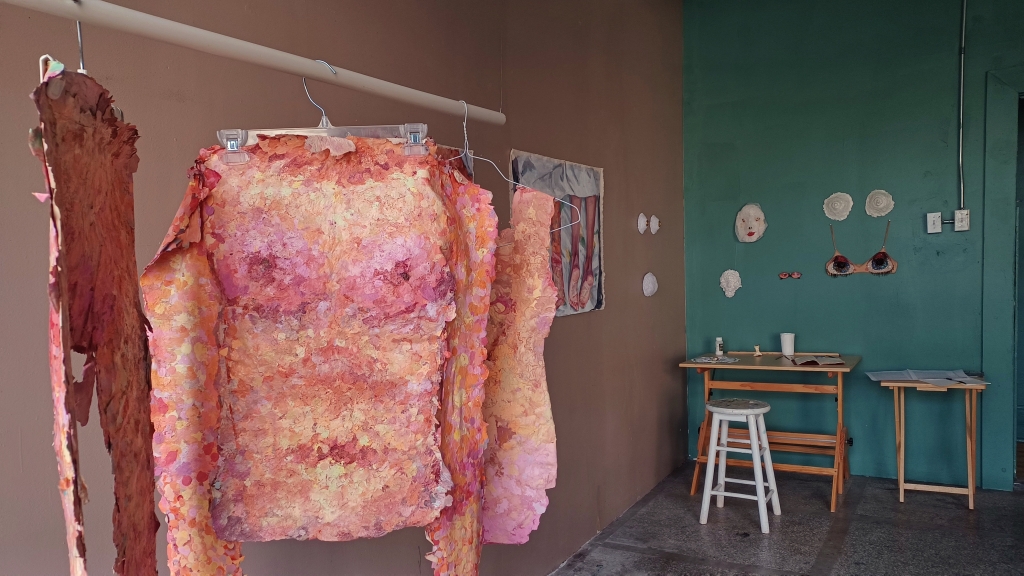
Sokolovskaya moved to New York City in 2016 when she began studying at the New York Academy of Art. NYAA has an esteemed MFA program, and is known for classes which focuses on technique and working from live models. After graduating, Sokolovskaya maintained a strong studio practice, during which she has explored painting pleinair painting, oil painting on mylar, textile art, making shaving cream monotypes, and more. Her experience at the prestigious NYAA refined her painting practice, but also seriously loosened her up and gave her oeuvre a sense of cohesion. She learned how to paint the figure from life, to work more quickly, and to paint more boldly with larger brushes. The result is that her paintings are more dynamic, immediate and approachable and they mesh successfully with her more experimental and playful pieces.
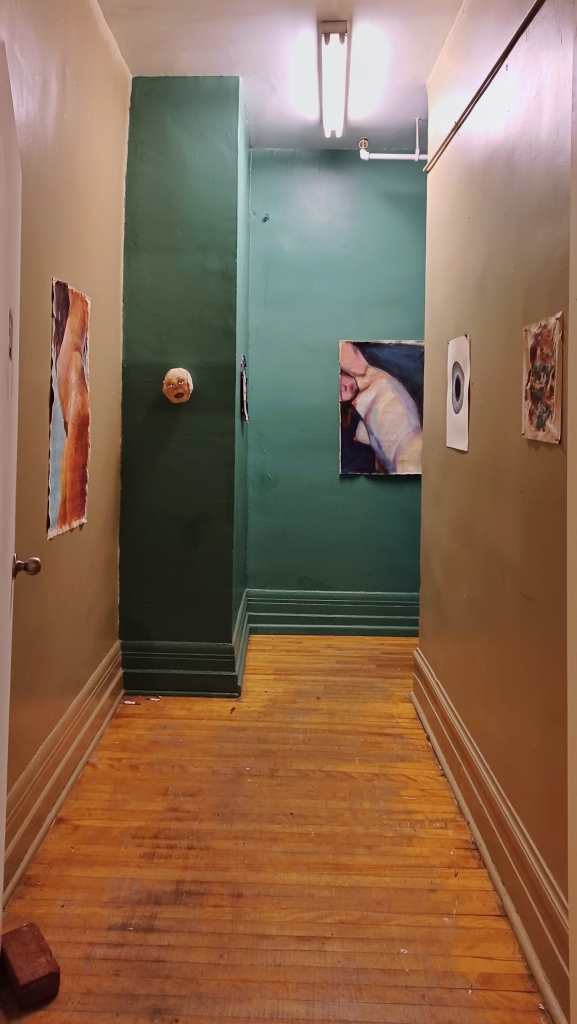
When you enter It is the Closest We Will Be, you start with a mix of new and old, prints, paintings, and two fibre works, on the whimsically-painted early 20th century walls. The choices make more sense as you take in the entire exhibition. To our left, we see the distended torso of a woman with long brown hair hanging in tendrils like Medusa’s snakes, a fragment of the artist. We cannot see her face, but this oil and oil pastel painting’s title, Disease or Desire, asks the question most on the viewer’s mind. Golden Tooth, Beaded Eyes a stuffed and beaded textile piece that looks like a mask almost seems to mock or threaten us as we approach, like a gargoyle warding off those who may not appreciate the show with its bared beaded teeth and beady eyes. On the walls of the hallway leading to the main exhibition room, we see two more fresh oil paintings from this year. Curved, in cool violet, blue, and lemon yellow, is a self-portrait nude torso that shows a body that seems to bend in a stretch, or perhaps just an odd position as she uses the selfie camera on her phone. Also pinned up in the hall is a painting of the arm of the artist’s father painted lovingly and softly against the luminous folds of a pink duvet. The works in this transitional space set the mood for self-reflection and family history. A bright abstract acrylic skin shows us that things are about to get weird.
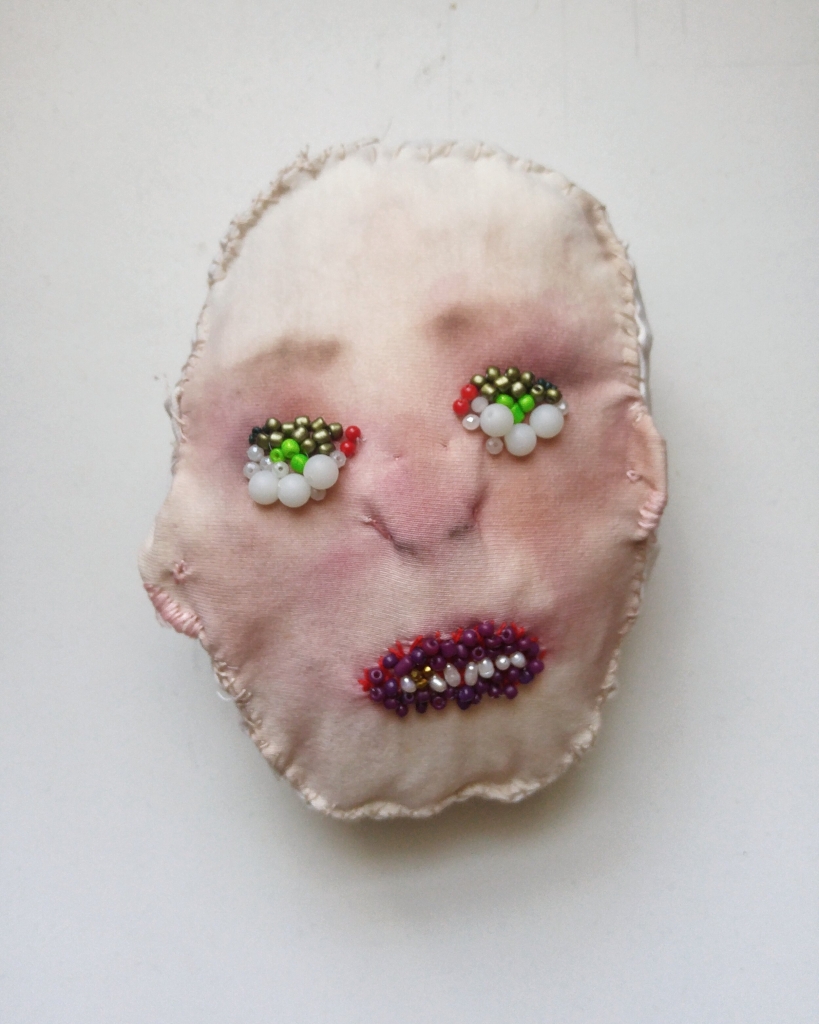
Entering the unconventional main exhibition space, the viewer is probably unsure whether they are intruding upon a private studio, as there is an odd combination of coloured walls, paintings on the wall, odd works scattered about, furniture, and objects which are not normally seen in an art gallery. In the corner to the right of the entrance is an artist’s working station. On a drawing table are a sketchbook, a few art supplies, and a papier mâché Opus card that would definitely not get you a ride. Upon closer inspection we find a lumpy paper cup with questionable ability to hold a drink, and a papier mâché painted apple core, surprisingly detailed, evoking an image of the artist having just left off sketching and snacking. Set up near the work station are a bra with detailed eyes, both seductive and creepy with beaded eye-whites. You can imagine a needle piercing the eye again and again, and lower eye lashes dangle strangely. Above this bra, as if just stripped out of it, are pearlescent white papier mâché sculptures of the artist’s champagne glass breasts. Kitty-corner to those works is the shape of Sokolovskaya’s belly, and above it, gold-tipped breasts.
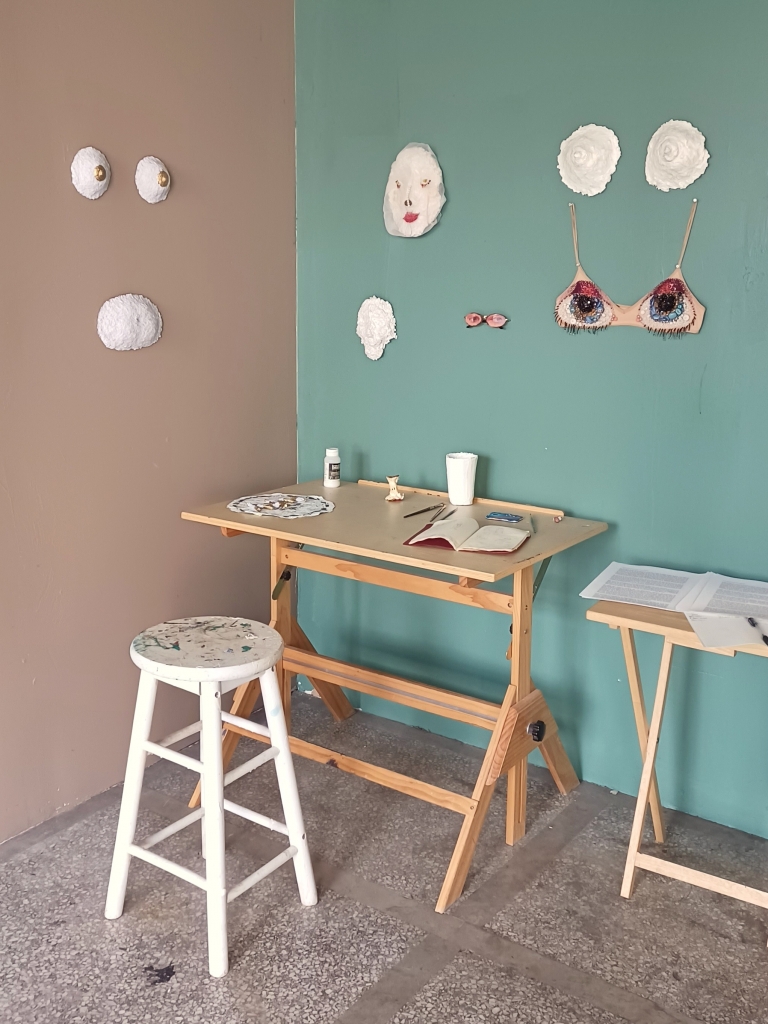
Attention grabbing works a bit further into the space are the bright acrylic skins hanging near the middle of the gallery that are made to look like human skins. They are both funny and grotesque, draped over coat hangers suspended on a closet bar, as if the dotted paint garments are the artist’s human self waiting to be put on. The skin, our largest organ, allows us to feel, to touch and be touched, and to a figurative painter, the skin is so important. The way human skin looks in different light, the way it can reveal our inner workings, our muscles and bones underneath, the ripple of cellulite, the pulse of blood, our fragility, our textures. To paint skin well is to have mastered one of the most difficult things there is to paint.
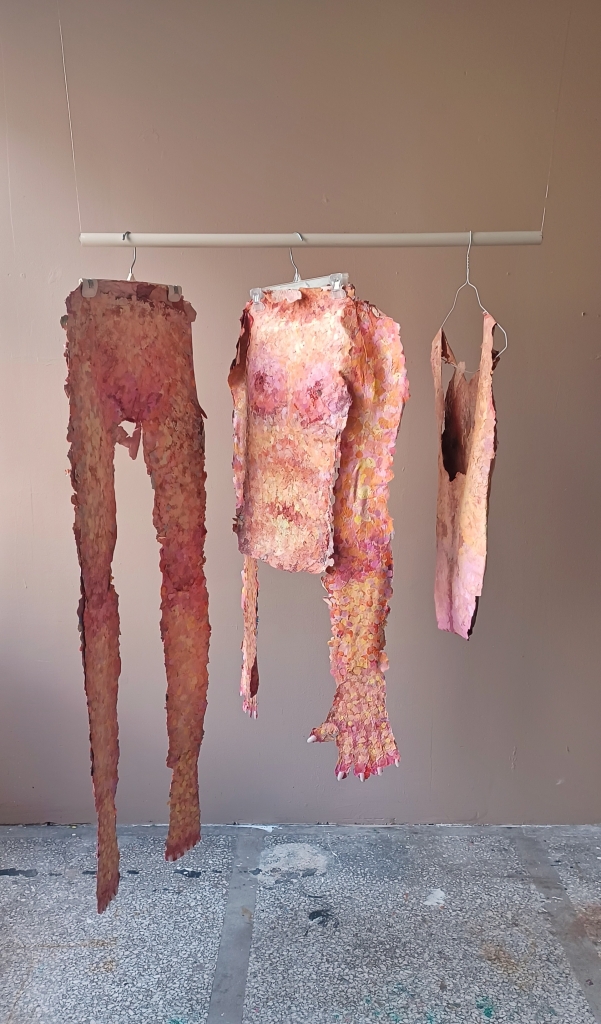
Pinned unstretched on the wall near the skins are oil paintings of Sokolovskaya’s lover posing with them. It is a bit meta, since the acrylic skins are rendered in a painterly, almost pointillist or pixelated way, and then we have two paintings from this year of the skins posed with real humans. In My Bed, shows lovers’ legs stick out from under the bed covers along with the feet of her acrylic skin. It makes me think of someone sitting with the memory of a person who is about to fade away, vanish into little dots of colour. These paintings show intimate scenes, that are a bit comical and also sad in a way. They remind me of how we sometimes cling to outworn relationships, to who we thought our lovers were, to the memory of them. On the other canvas, Your Arm, Sokolovskaya’s lover’s arm is embracing the skin of her body left behind, as if she shed it like a snake and he remains in bed with what is left of her. The human experience is inherently tied up with mortality, with wear and tear, with love and loss. Sokolovskaya touches upon this with quirky curiosity and a touch of existentialism. The unstretched canvases themselves speak to the transitory nature of the artist’s relationship between New York and Montreal. They were rolled and put in her luggage and brought on the train from city to city.
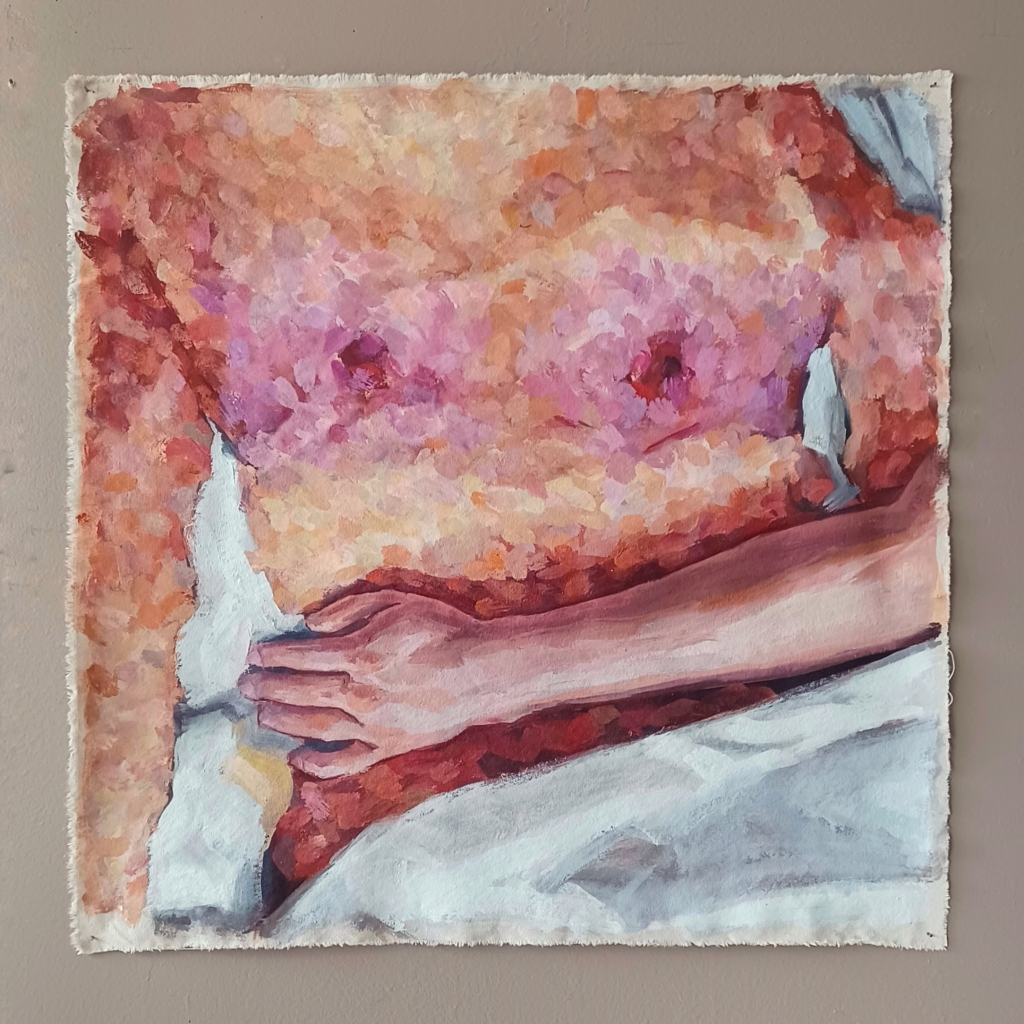
In painting, Sokolovskaya often makes portraits, painting models in class, friends, and most typically, herself. She is interested in moments that are unposed, unusual, funny, and even unflattering. Conventional beauty is not a primary interest to her in making work, and she even explores what many would call ugliness, and yet her work is often beautiful because of her skill with light, colour, and her ability to seemingly effortlessly render skin, bone, and body through a series of dynamic, rapid, yet keenly observed brushstrokes.
Perusing the show feels as if you are creeping in voyeuristically on a private space of the artist in an intimate moment. The ghost of Sokolovskaya—painted loosely on a clear curtain— showers nude in a corner, while on the bed a slice of New York margarita pizza waits for her. Blue-rimmed bowls from her childhood in Uzbekistan and round, hearty Uzbek bread are memories waiting to comfort her, while on the futon bed is a Tarot spread of three cards perhaps indicating a question about the future. The thick cards, the Tower, the Fool, and the Magician, set the tone for change and upheaval, with a touch of hope. The cigarettes which discretely fill the space, in corners, on the sheets, in a bowl, suggest the persistence of a habit, or anxiety. The butts glow with life, skillfully painted, they seem hot and flammable. Some are long with ashes, and some are even gold, as if they are fantasy cigarettes. Sunny side up eggs are scattered around on paper plates, and even loose on a shelf, making the place appear both strange and lived-in. Are these dreams of eggs? Who is this messy, hungry person?
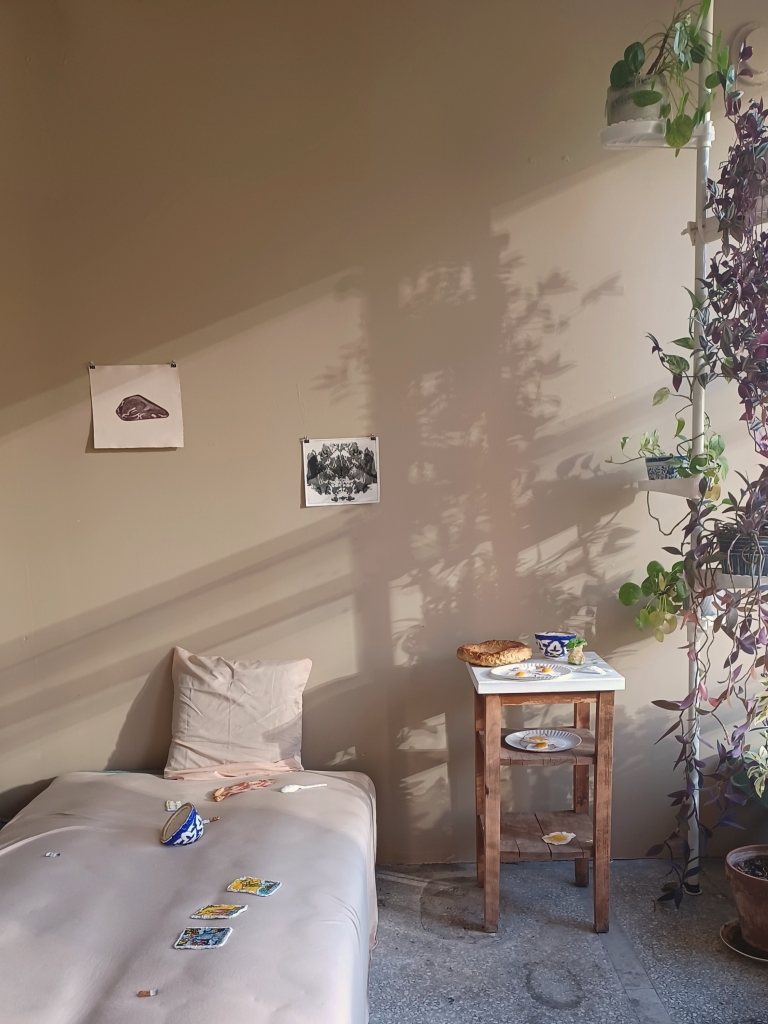
We find her painted loosely in the corner on the shower curtain, a nude brunette, soaping her pits. Acrylic skins of a one-piece bathing suit and bra and panties hang beside. Perhaps the artist is showering paint from her body, or returning from the pool, and will get dressed afterwards, have a cigarette, and think about her next painting while eating her slice of pizza or finishing her eggs. On the bed we find an acrylic skin of a sock that looks like it could have come out of a Phillip Guston painting. Papier mâché Opus and Metro cards make it especially clear the on-the-ground relationship to both cities Sokolovskaya has, and they are strikingly accurate, but also cartoon-like, somehow, in the way they are rough and thick, the opposite of what the sleek familiar cards are. The most erotic painting in the show, Red Body, is an oil painting tacked up by the shower, a pink torso of Sokolovskaya done from a steep perspective that calls to mind nudes one might send to a lover late at night, as seemingly huge fingers graze the bare surface of her pubic mound and her breasts fade off into darkness. The image is faceless.
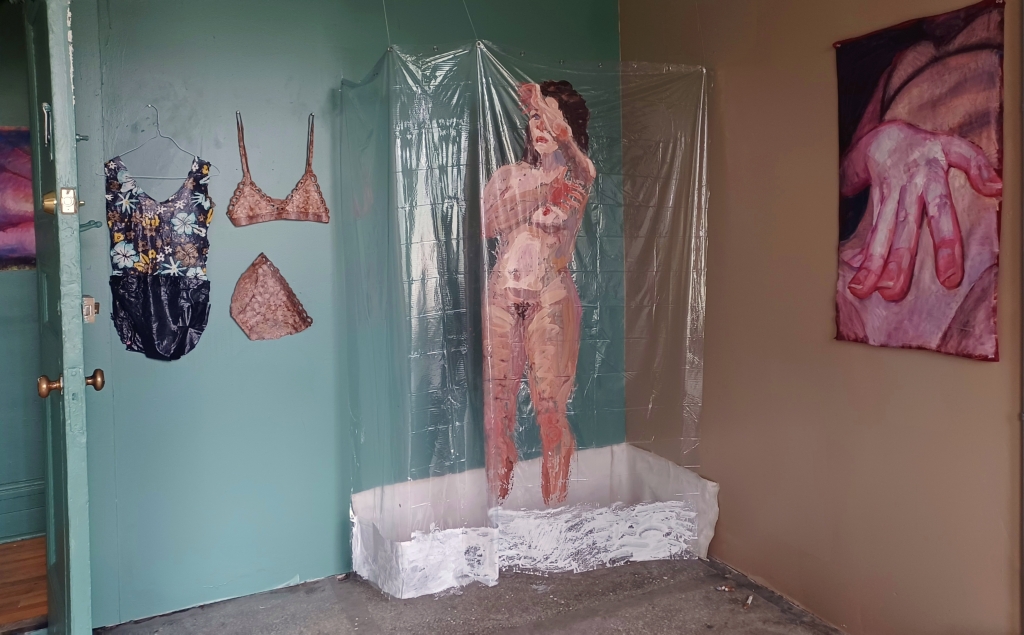
There is a zest for life here, a hope for the future, and a nostalgia for the past, what could have been, what was and what wasn’t. The works call to mind the way that memory functions, they are wobbly, melting away in a moment. Memories are not as clear from year to year, and eventually they become memories of memories, cartoon-like. Sokolovskaya’s first solo show is a synthesis of everything that came before, and a promise for what is to come, when she returns to Montreal—as this exhibition foreshadowed—to live and work. As in Joseph Campbell’s Hero’s Journey, however, she doesn’t return empty-handed. She returns with new knowledge, new skills, new relationships, and the drive to create new works. She also returns with the aim to create community, which she has been doing for a few years now with her Artist Confluence project that she is bringing to Montreal.
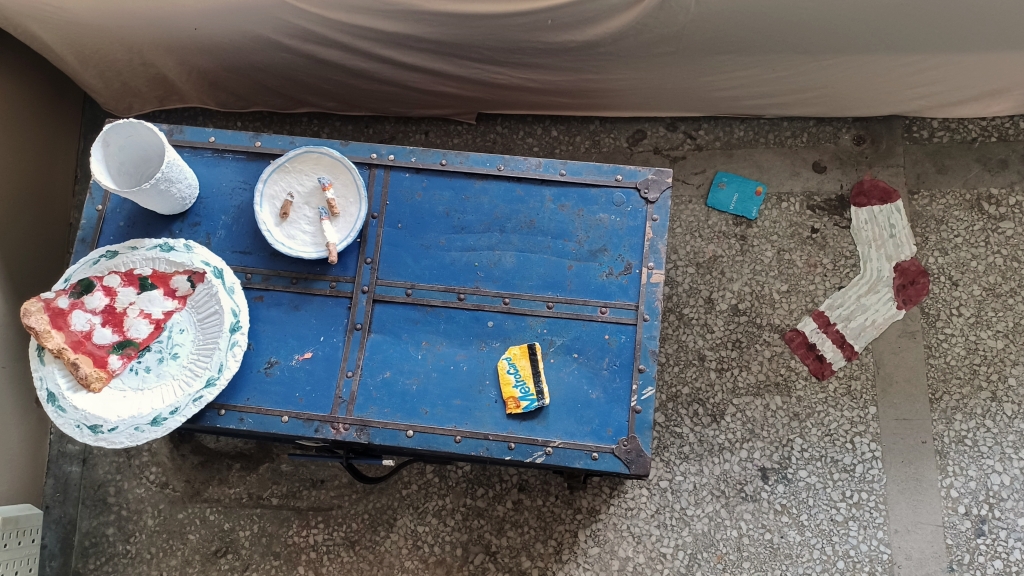
It is the Closest We Will Be is a strong first show from an artist keenly interested in personal reflection, materiality, and experimentation. Deeply considered and finely executed, the works in this show don’t take themselves too seriously. Sokolovskaya seems to have an innate understanding that life is best felt deeply and lived lightly. To do being human well is to be powerfully present while remaining skilled at all the release and letting go that necessitate the mortal experience. In this installation there is a fascination with the self that is the pursuit of many figurative painters, especially young ones—the questions “Who am I? Where have I come from? Where am I going? Why am I here? Can I make others understand me?” arise from all deep thinkers and feelers. But beyond the personal, there is also a fascination for what it means to be human, what it means to deeply inquire, to deeply seek to understand and interpret one’s own human journey, which, although unique, is an experience we all share.
The post It is the Closest We Will Be first appeared on The Belgo Report.
]]>The post La Rentrée au Belgo first appeared on The Belgo Report.
]]>La dynamique communauté artistique du Belgo vous convie chaleureusement à célébrer avec nous la rentrée culturelle d’automne 2023!
En tant que l’un des plus grands regroupements d’organismes dédiés aux arts contemporains à Montréal – abritant de nombreuses galeries d’art, centres d’artistes et d’exposition, ainsi qu’une variété d’organismes culturels – cet événement est une occasion exceptionnelle de plonger dans un univers de créativité et d’inspiration. Le 14 septembre prochain, de 17h à 22h, nous vous ouvrons nos portes afin de vous offrir un éventail d’expériences entièrement gratuites et accessibles à tous, en compagnie de plusieurs des artistes exposants.
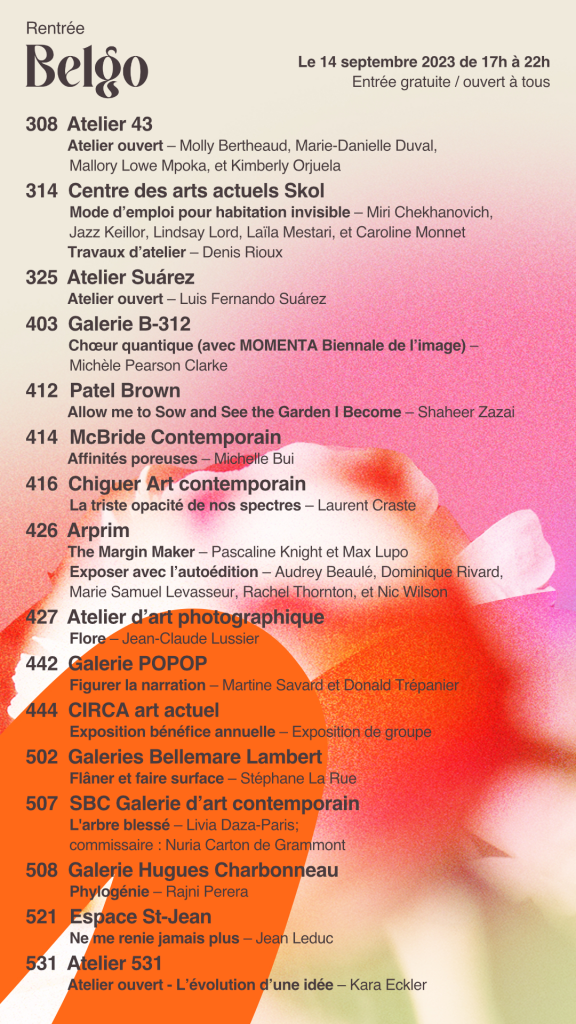
Join us in celebrating the much-awaited 2023 Fall opening of The Belgo, a cornerstone of Montreal’s vibrant artistic community!
As one of the largest gatherings of organizations dedicated to contemporary arts in Montreal – housing numerous art galleries, artist and exhibition centers, and a variety of cultural entities – this event represents an exceptional opportunity for you to immerse yourself in a world of creativity and inspiration. On September 14th, from 5:00 PM to 10:00 PM, we open our doors to offer you an array of entirely free and accessible experiences for everyone, in the company of several of the exhibiting artists.
The post La Rentrée au Belgo first appeared on The Belgo Report.
]]>The post What For My Maddened Heart I Most Was Longing first appeared on The Belgo Report.
]]>Atelier Suárez, Belgo Building #325
As you enter the space you are aware that this is something different. It is not a white formal cube. You might even be a little confused. You’ll stop in your tracks for a moment, trying to figure out if you are welcome or trespassing. At the entrance, you are greeted by 4 large scale paintings and as you look around the space, you see a chair with some clothes on it, white socks and high heels on the floor below it, red candles burning, a wig and with the corner of your eye you notice a blue shirt hanging on a hanger. Right in front of you, there is a big blue painting. A man is standing with his back to you, in a blue bathroom, brightly lit by the sun coming through a window. Does the shirt belong to the man depicted? He is naked and is taking a step towards the sink. You are witnessing an intimate moment and you are unsure if your presence is known or not. Will he be surprised if he turns around? Are you allowed in?
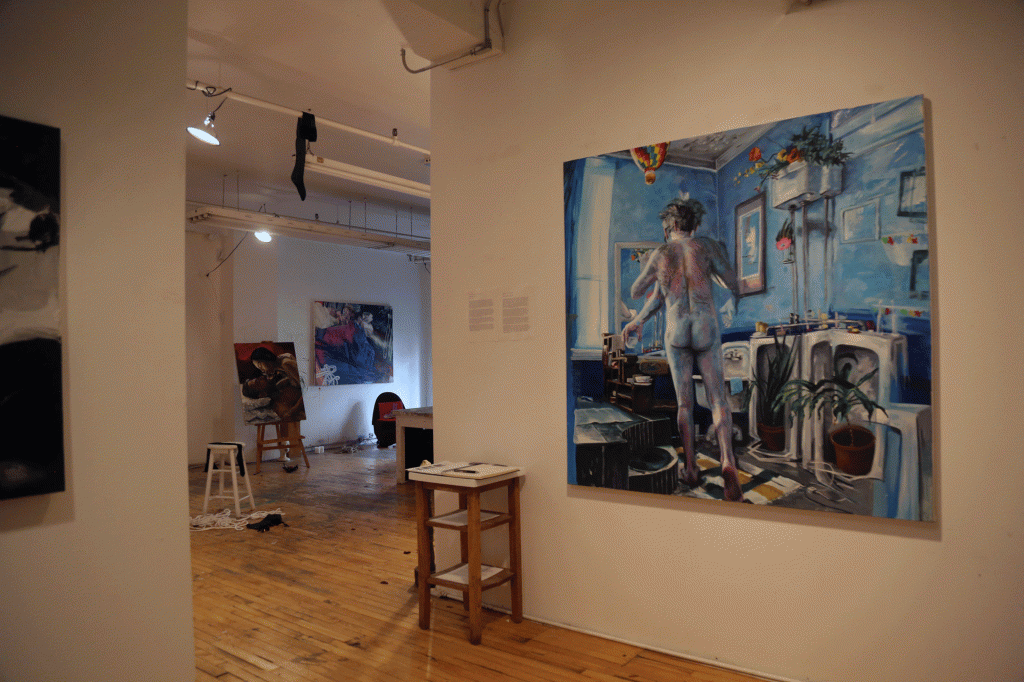
These are the questions the viewer is facing in this show. What For My Maddened Heart I Most Was Longing presented in Atelier Suárez, is Kara Eckler’s first solo show in Montreal, which displays works spanning two decades. The title comes from Sappho’s Hymn to Aphrodite translated to English by William Hyde Appleton. In the hymn Sappho treats themes of love, devotion, desire, religion, and heartbreak, Kara Eckler’s show touches upon themes of intimacy, sexuality, eroticism, and mysticism. There are ten large scale paintings on the walls and 16 smaller pieces that are presented off the wall. The space around them is filled with familiar objects like lingerie, bottles, candles, ropes, bags, shoes, and wigs which complement the work. This presentation heightens your awareness that these paintings are part of lived reality, they are the artist’s experiences. In this show, you can’t help but feel a little voyeuristic, shy, and awkward, facing things that are usually kept private.
Sex and intimacy so often stay behind closed doors, in password protected folders, in erased browser histories and whispers. However it is also an important element of our human experience that we cannot ignore. Kara Eckler courageously opens up, allows you to witness her and her loved ones, which hopefully prompts you to open up in return. The nudity isn’t shocking as one might expect, it’s vulnerable and real. It isn’t the lustful gaze of a voyeur, searching scenes that titillate, but the loving gaze of a participant, someone who shared these moments. You are privileged to be invited into the world of those depicted.
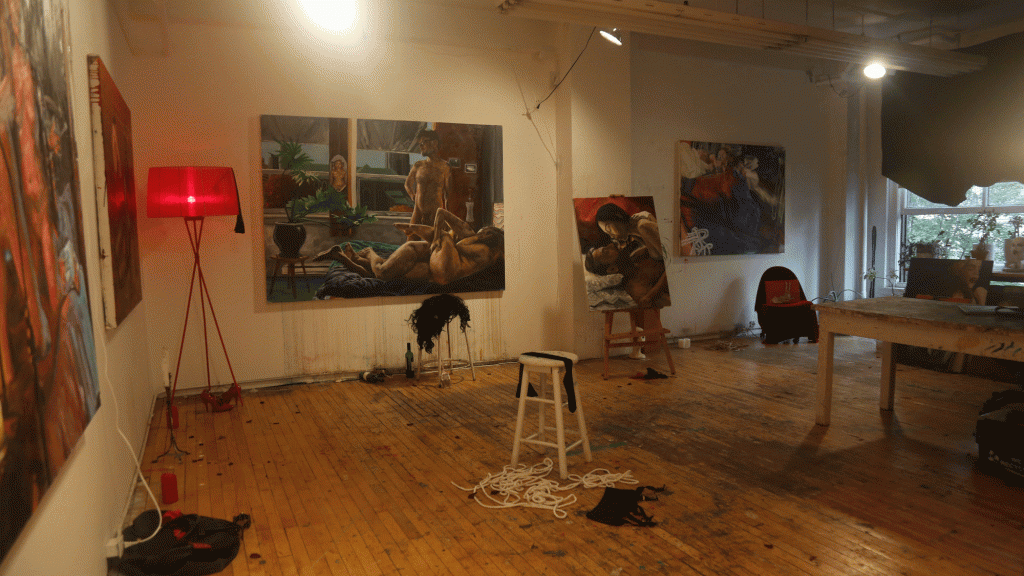
Two narratives emerge in the show, the one of the painted world and the one of the real life objects. These objects play a double role, some are a way into the painting, an element that comes to life and allows you to understand what is happening, others present a riddle. In the forefront of The Witches’ Sabbath, which depicts two female figures reclining in bed, you see a wine bottle and a glass, you’ll notice the same dark glass bottle, right underneath the painting, sitting on the floor, like a relic of moments past. On the floor by Watching, Waiting, Waking, a dark red canvas, depicting a reclining female and a small, curled up male figure in the background, you see a candelabra. Are these candles here for illumination or part of a magic ritual? You notice the female figure’s harness and the hint of wings on the male. The piece feels both calm and eerily gloomy, as if the two are stuck in some sort of wasteland or limbo. The uncertainty you feel about the meaning of this piece is repeated in others and heightened through surreal elements of extra limbs, doubling, recurring characters, and fantastical elements throughout the show.
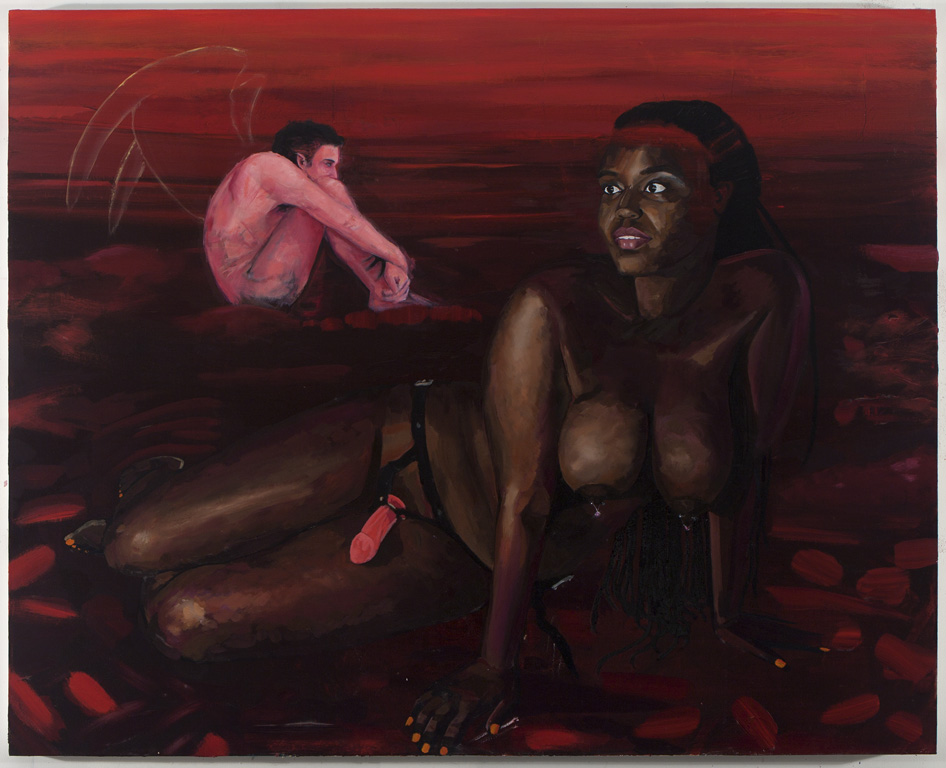
Kara Eckler’s foray into mysticism started early. In 2002, after receiving her BFA in Painting and a BA in Creative Writing in Albany, NY, she moved to Canada to study Tantra and meditation. You can clearly feel the influence of that, both in the paintings as well as the presentation.
Kara Eckler has undeniable skill and ability to paint in an idiosyncratic way. You can connect to her works through their humanity and vulnerability as well as by appreciating the beauty of putting oil paint to canvas. She is striving to show the viewer the reality she has witnessed or participated in, but she is also allowing her medium to enhance that. She is not here to spell out everything for you. She might render a plant, a glass, a foot, a breast, but she is also allowing the freshness of a quick first layer to show in a hand, a window, or a bed. These painterly moments make you wonder, is this a memory or a fantasy? Are those your memories and fantasies?
In the middle of the room stands a painter’s stool, with coils of rope and a paintbrush, which feel like metaphors of the themes of the show. The brush points to a visible love for painting, particularly oil painting. Large canvases, bold thick brush strokes, saturated colours, and human figures almost life size are the hallmarks of a painter in love with the medium. Rope on the stool that we see tied as a pentagram harness in The Witching Hour remind us of power exchange practices, magic, rituals of binding and constricting, but also the incredible need to trust the world and to let go, just as a painter does in the studio.
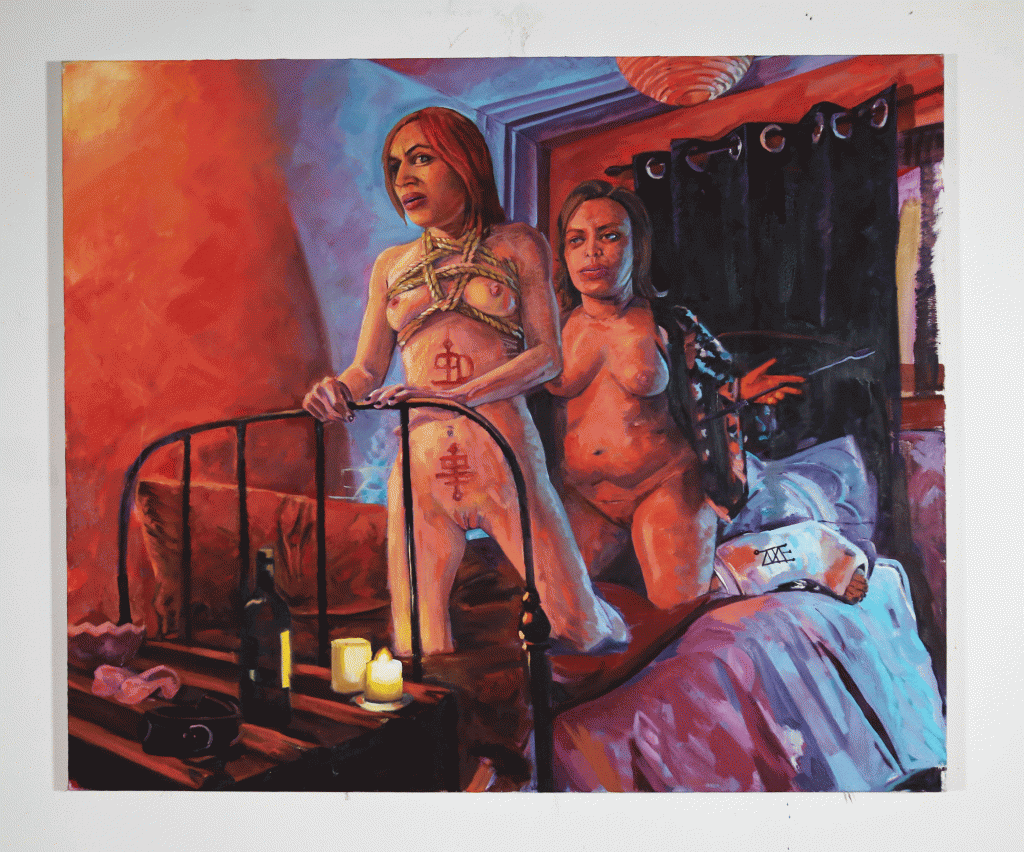
What For My Maddened Heart I Most Was Longing is a bold challenge thrown at the viewer. The taboo surrounding the themes explored might not be everyone’s cup of tea, but it is undeniably daring to open yourself up as Kara Eckler does. These paintings depict nudity, sex, and mystical practices. The scale is imposing, the people real. No-one is hiding under the hairless, peach coloured, blended skin of french academicism. What you see, is what was lived.
Liza Sokolovskaya
The post What For My Maddened Heart I Most Was Longing first appeared on The Belgo Report.
]]>The post Annihilation first appeared on The Belgo Report.
]]>Please click page flip button to read the next page.
The post Annihilation first appeared on The Belgo Report.
]]>The post À l’ombre d’une corolle: Dominic Papillon first appeared on The Belgo Report.
]]>Galerie Bellemare Lambert April 8- May 6
À l’ombre d’une corolle
The title of Dominic Papillon’s latest solo exhibition at Galerie Bellemare Lambert loosely translates to In the Shadow of a Flower Blossom. Both the show’s title and the titles of the works provide poetic entry points, giving us a riddle or a clue while not telling us everything. I first noticed Dominic Papillon’s work at Papier in 2022 when his sculpture, Dure-Mère II was presented at Galerie Bellemare Lambert’s booth. At the Belgo, I was able to enjoy this paper, wax, and watercolour figurative sculpture more slowly. Dure-Mère II directly translates as “hard mother”, but the phrase is a scientific term for the outermost membrane of connective tissue which protects the nervous system, the dura mater. This is an interesting play on words, evoking both the ubiquitous human experience of being born to a mother, and also a thin layer that protects our vulnerability. This hollow sculpture represents a walking or posing human form, the sex unidentifiable. The paper and wax construction seems to refer to the delicacy of the human body, while the vibrant hues of the watercolour bring it to life. A headless and hollow form, this sculpture is in its foundation paper white flecked with salmon pinks and blues which give it the appearance of a gorgeous seashell, but also of disease, or varicose veins visible through translucent human skin. This seems to be a skin that someone has shed, leaving a shell behind.
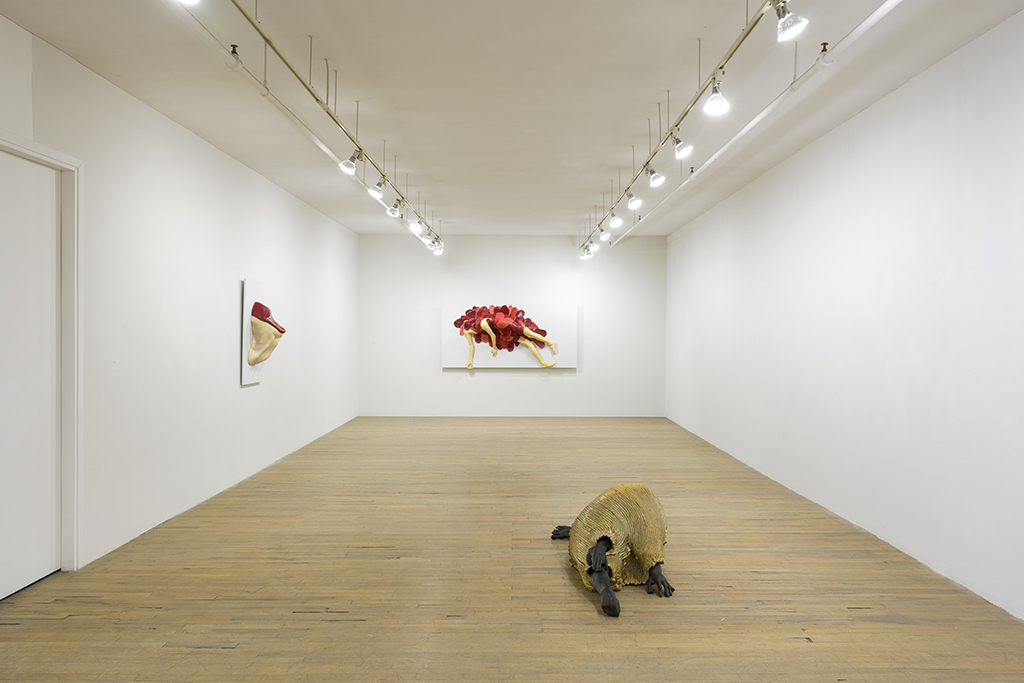
The work of Papillon is often simultaneously beautiful and grotesque. It calls to mind the complexity of the human condition, in that all that is gorgeous, enjoyable, and pleasurable in life is also temporal and bound to fade or end abruptly. We exist in places and forms which can have only temporary beauty; the material world is continuously replicating itself and leaving behind what is outworn. Is the frailty of the human condition what makes life so precious? When will the threat to the survival of our species make us treasure our own lives and the life of our planet?
Born in Quebec, Dominic Papillion lives and works in Montreal. He obtained his baccalaureate from UQAM in visual and media arts, and his master’s degree in sculpture from Concordia, where he now teaches sculpture. He is represented by Galerie Bellemare Lambert and he has shown there since 2015, and has had other solo exhibitions at Maison de la culture Frontenac, Plein Sud in Longueuil, Circa Art Actuel in the Montreal, Regart in Lévis, Sporobole in Sherbrooke, and Galerie Verticale in Longueuil among others. Papillon’s use of the human form in a playful but also serious way to evoke emotion and the human experience reminds me of the character of some works by Kiki Smith and David Aljmedt, but, of course, he has his own unique language.
Perhaps the most striking piece in the exhibition is a wall-mounted human form at the back of the first room in the gallery. Humeur acéphale II shows a limp, headless body with a sickly pallor, stuck to the wall with large daubs of pink or wine-coloured wax which resemble deflated balloons or oversized flower petals. These coloured wax pieces stand in warm contrast to the corpse-like tones of the figure, which, laying limp, recall Jesus being taken down from the cross, a scene recreated by so many artists during the Renaissance as The Deposition. Gallery director Christian Lambert said he admired the figurative wax pieces for their resemblance to marble, and indeed Papillon’s wax works do evoke classical marble figures from antiquity.
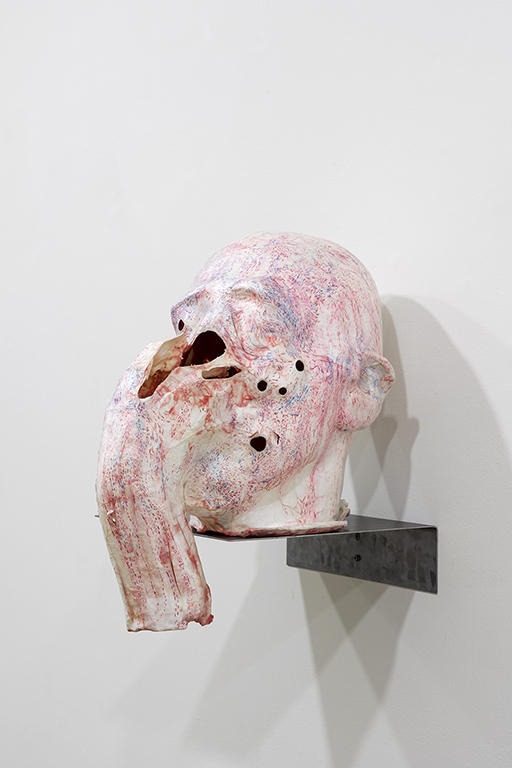
The grotesque has long been a part of Christian art, with sculptures of suffering Christs or saints martyred prominently displayed, mostly in churches, reminding us of their stories. A wax figure also evokes death in other ways, sometimes creating a look that is reminiscent of the tradition of human bodies presented after death preserved in formaldehyde, made up and patched up with putty so that their loved ones can regard them one last time and say goodbye. Our culture has a strange relationship with life, often not valuing it while alive, but also not giving much attention to death, avoiding thought of such matters, thereby keeping death out of sight and out of mind. Wax is an interesting medium for a sculptor to work in, it resembles the human body in texture and feel, and as such, it can be used to get remarkably life-like effects. The heating and drying process of the material makes it very malleable, but also vulnerable to changes in temperature. Wax is also used by sculptors in techniques such as with lost wax casting. Wax work figures are a fascinating and kitschy human preoccupation often shown in museums as a tourist attraction, showcasing famous figures in a bizarre state that is at the same time very life like, very dead, and also often comical.
One of the most intriguing pieces in the show is Papillon’s Humeurs acéphales, a ceramic work where the figure is cast in nearly matte black is emerging from underneath a gold-coloured blanket made from thick coils. The person underneath seems to be undergoing some sort of transformation, and three feet can be seen along with three hands. Is there more than one being underneath, engaging in carnal activities? Or do the hands and toes tense from pain? No head can be seen, and from the title we can wager that what is felt is of the mind, not of the body—the title of the piece translates as “headless mood”. To quote Lewis Carroll’s Alice in Wonderland, “don’t lose your head!”
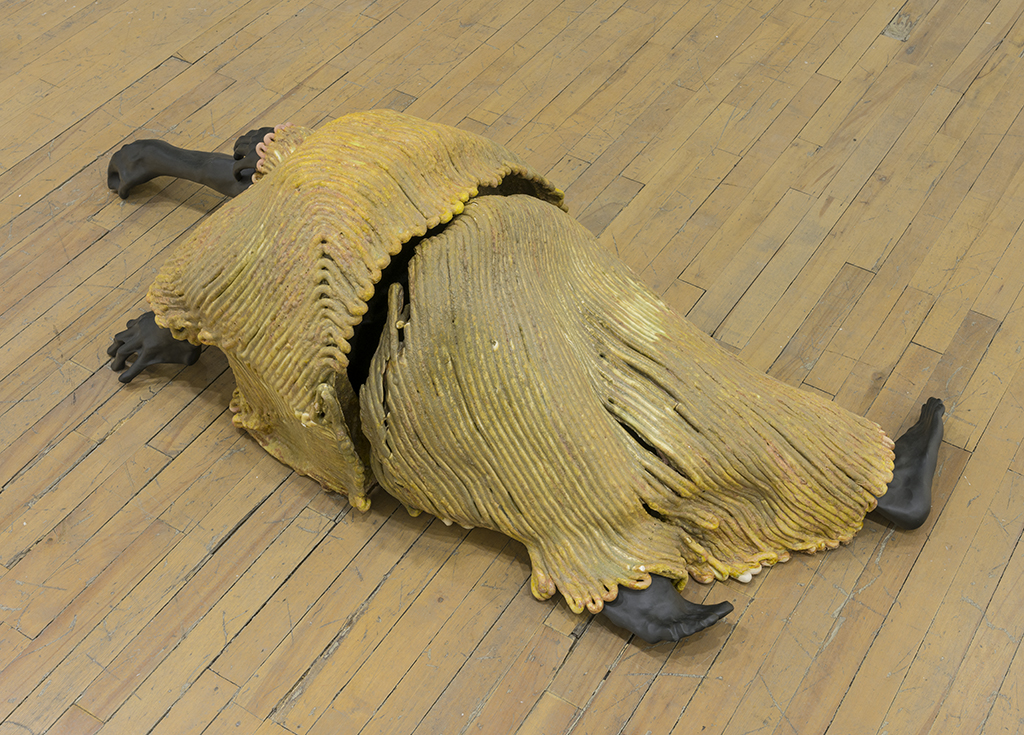
Alanguissement is another work that plays on words as well as forms, and brings some levity and pop-style (think Rocky Horror or the Rolling Stones). The word alanguissement means languor, which is a mood of lassitude or indolence. A langue is a physical tongue as well as a language, and a huge, lolling, red wax tongue is what replaces the face on this pallid waxen bust. The man seems to be taste itself, his shoulderless huge throat emphasized by the way it emerges from the wall. Most of the head isn’t present, it is simply a massive, smooth, wax tongue. What if taste had a face? What if, in the sensual experience of being in a body, taste consumed you were little more than a tongue? What kind of languor could bring about such a moment? Can our desire ever be sated?
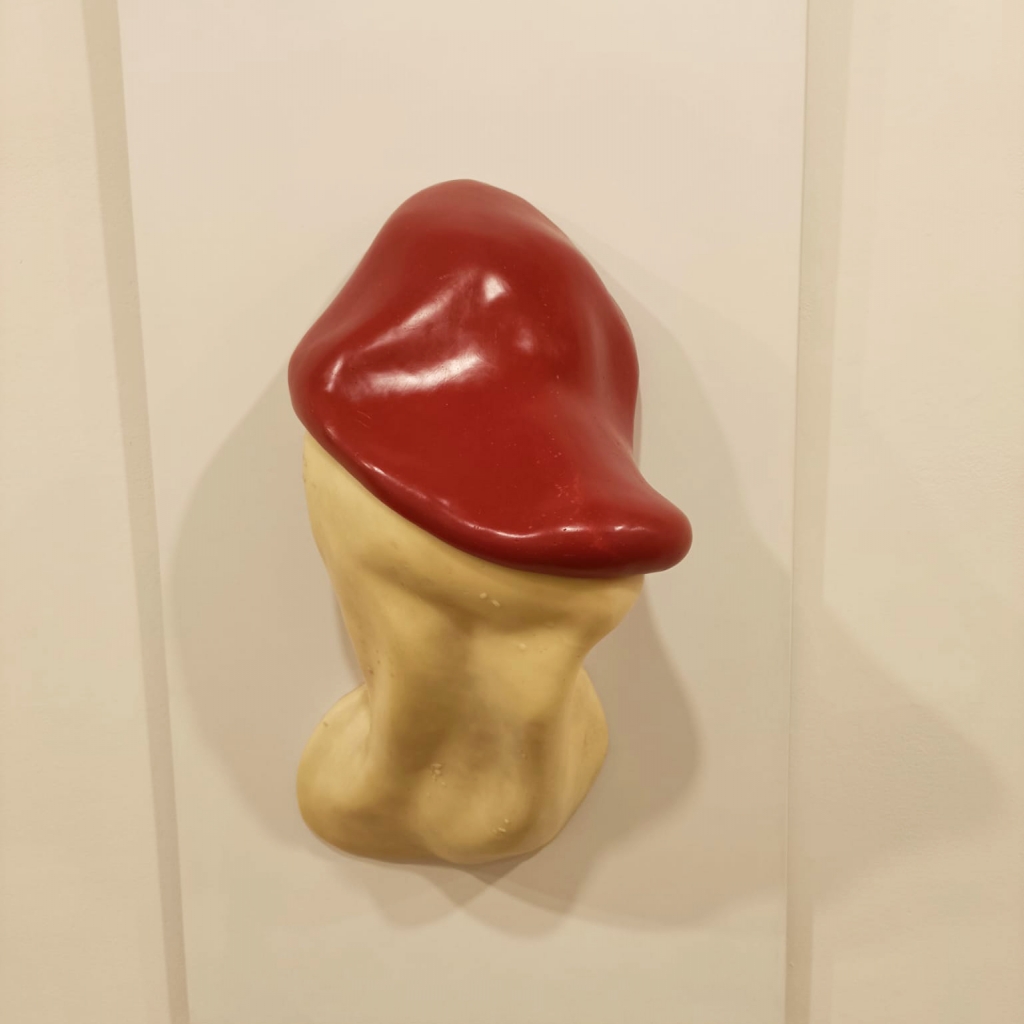
On the wall and floor we find Abattis I, II, III. Generally speaking, they are iron-coloured ceramic works representing roughly-hewn body parts. Abattis I is a skinny arm, Abattis II is an arm, elbow and forearm, and Abattis III is a more abstract and barely identifiable torso which is presented on the ground. An abattis is a weapon formed from a branch of a tree, sharpened, and laid out defensively before the enemy in war to delay their approach, so that they may be fired upon to exact the maximum damage. Are these body parts the weapons or parts of the bodies that were wounded by the weapons? Or both, as a human race we destroy each other, despite being one family. These body parts look worn down and manipulated by touch, we can see the impressions of the artist’s hands and fingers. The effect is reminiscent of the consequences of being human. It makes me think of all that touches us, damages us, wounds us, all the ways we cause hurt and are hurt in turn.
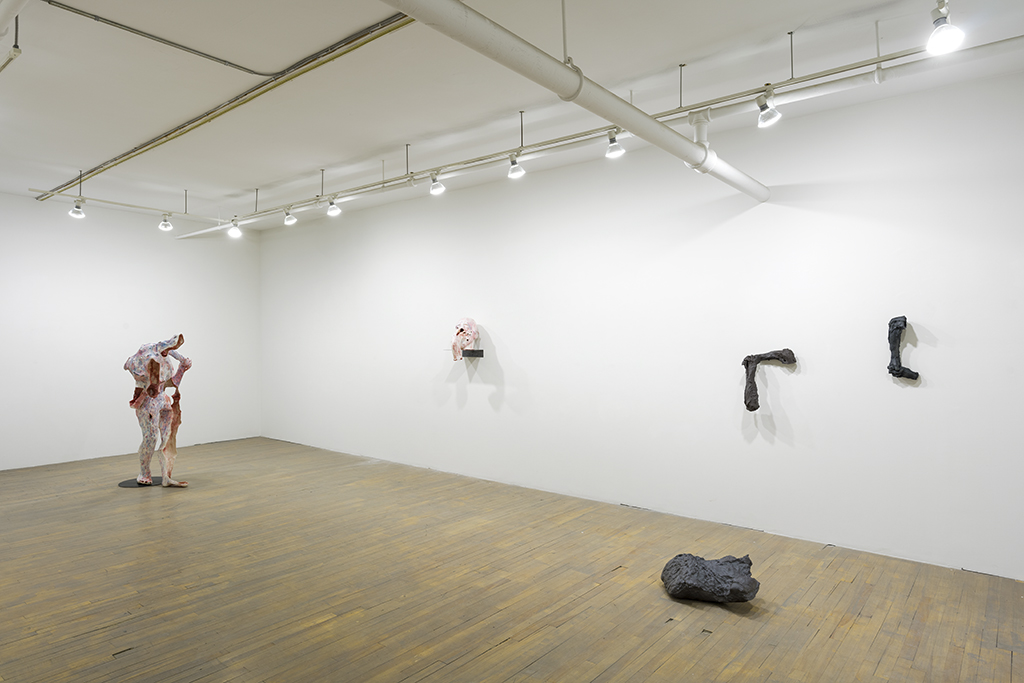
Near the Abattis sculptures is Dure-Mère I, a paper bust where the head seems to be tearing away layers of its own face with its hand. Like its sister piece, Dure-Mère II, this sculpture is also made from paper, wax, and watercolour, and the colour palette is the same. We seem to be able to see through its transparent skin to the capillary and vein systems. The piece is both lovely and discomfiting. Papillon’s work is unsettling in the way it reminds us of our own mortality and vulnerability, he seems to play with the human body in sculpture like a scientist dissecting a cadaver. In fact, Papillon’s work in this series reminds me strongly of surgical models used to train medical students, disturbingly lifelike, but also clearly not alive. These sculptures are momento moris, reminding us of our ultimate demise, but also of the beauty inherent in the forms which allow us to exist on this earth, to feel, to experience, and to create.
The post À l’ombre d’une corolle: Dominic Papillon first appeared on The Belgo Report.
]]>The post Starting Small first appeared on The Belgo Report.
]]>To anyone who lives in cities like Montreal or New York City, space is a luxury; to live in a 250-square-foot studio apartment in the downtown core, one must make creative choices to maximize the use of available space. Thankfully, artists thrive on limitations. Perhaps that’s why both of these cities have such reputable art scenes.
From April 13 to May 6, the smallest studio in the Belgo Building invites you to Petit et Intime: Exploration de peinture, textiles et photographies, an opportunity to discover over 41 small-scale works from a group of artists hailing from Montreal to New York City. The studio-turned-gallery unites an eclectic mix of paintings, textiles and photography, all of which are 12” x 12” and under.
When you happen upon the studio entrance on the fifth floor, you first peer into a whimsically painted corridor lined with artwork, beckoning you to wander inside. Following the trail of tiny frames, colourful fibres and canvas, you emerge into a cozy main room, flooded with light from two large windows. There, I was greeted by co-curator and figurative painter, Kara Eckler.
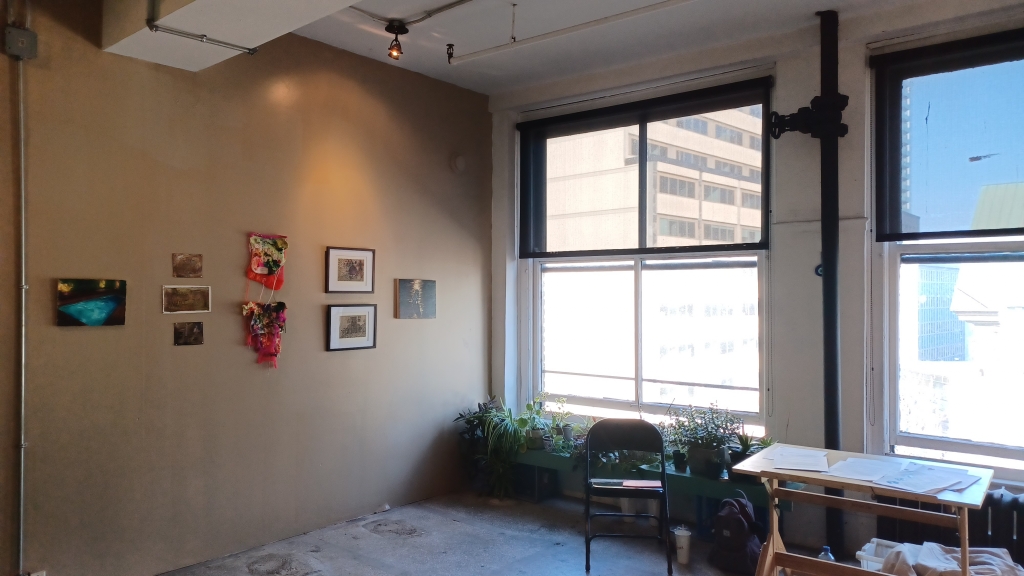
Liza Sokolovskaya, painter and mixed media artist based in Brooklyn, is the other half of the curating duo that sought to gather the works of independent artists deserving of a closer look.
“We asked the artists to submit up to ten of their smaller works, including studies that may lead to larger works in future iterations, and we selected two to three for the show,” said Eckler, “there are so many talented independent artists out there who are not represented by galleries, and we wanted to give their work the attention we felt it deserved.”
The two curators deftly arranged the submitted works into a cohesive narrative, despite the pieces originally sharing no thematic connection aside from their scale. Featured artists include visual artist and writer Lauren Anders, painters Sophia Skayafas and Zachary Sitrin from New York City, painters Madeline Richards, Ben Williamson, Mary Hayes, Heather Euloth, Heidi Daehler, Jessica Joyce, Karine Guyon, Alex Coma, Colette Campbell-Moscrop, and Luis-Fernando Suárez, photographer Lekui, and painter and fibre artist Lea Elise, from Montreal.
To fully immerse yourself in the experience of Petit et Intime, you must accept the invitation to stop, lean in and decipher. Though the works are small in size, each one draws you in with a powerful inquisitive force, daring you to explore far beyond the boundaries of the material.
This challenge to examine the content through the container’s surface becomes immediately apparent with the very first set of pieces flanking the gallery entrance; Study for The World Made Strange and Study for Butterfly 1, two pastel studies by Madeline Richards. In both pieces, we see human limbs emerging from a body of water, held afloat by soft pink flotation devices. In Study for the World Made Strange, the limbs are almost disappearing below the surface, seemingly flailing to remain visible. In the second frame, a body glides at the surface, buoyed by floaties arranged in a way that resembles butterfly wings. These pieces set the mood for the exhibition, where the viewer will be in a constant state of negotiation as to whether to tiptoe gently along or dive right in.
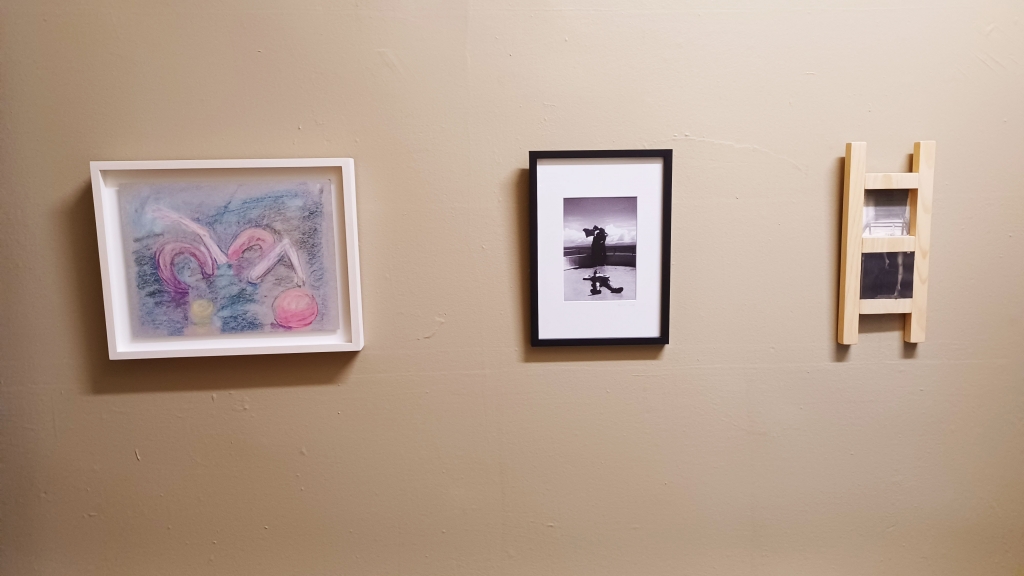
In Pensées roses by Kara Eckler, a woman sits upright in her bathtub, gazing down at her naked body, her corporeal shape hidden by the edges of the tub. Though the scene is voyeuristic, the painting has a rather soft and tender quality. This feeling lingers as your eyes drift onto its neighbouring piece, Built a home for you by Heidi Daehler, where you observe a deer through what appears to be a porthole window. In both cases, the viewer does not wish to disturb the subject, but instead hold space for their vulnerable stillness.
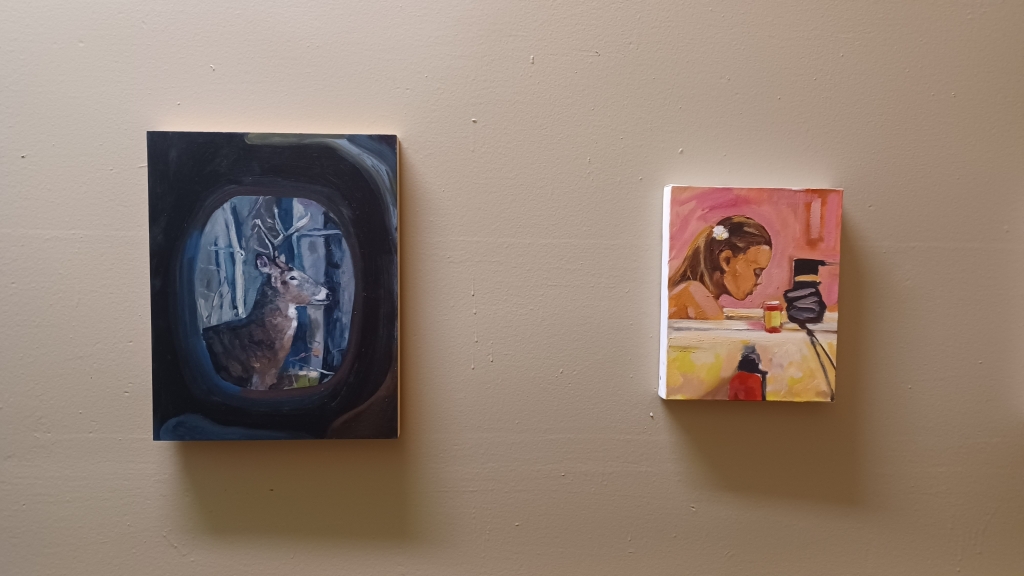
As you round the corner, the works become more abstract, such as a triptych of paintings from the series titled Touched by Jessica Joyce. The soft, bruise-like surfaces of the panels include visible hand marks, tempting you to press your digits against those of the artist, typically considered a forbidden act of connection between the art and the observer. Come closer, but keep your hands to yourself.
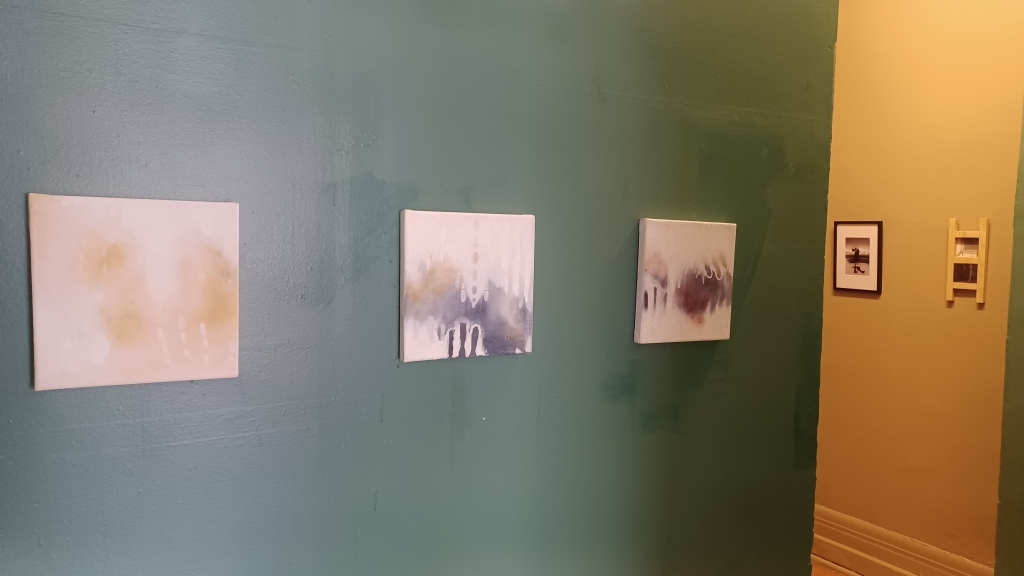
Playing against this soft stillness, the brightly coloured abstract fibre work of Lea Elise vibrates alongside neon abstract works Bewitched and Utopia by Karine Guyon. In this moment, the formerly gentle signal jams, producing textures and visuals reminiscent of glitch art. You might wonder what would happen, should these threads of wool, silk, and linen unravel, or the strokes of oil pastel lift off of the page. What messages would we decode from them? What immense web would they create?
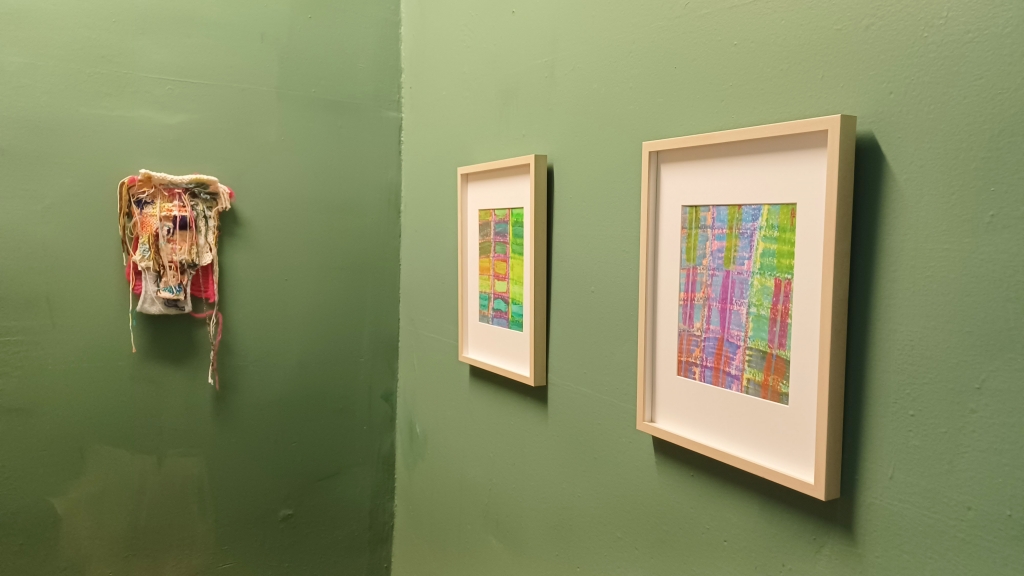
Before reaching the main room, I was intrigued by a tiny set of hands with their thumbs and index fingers joined together, welcoming us to the next stage of our journey. The Polaroid photograph captured by Lauren Anders, Untitled (Hands) is mysteriously charming. Again, the viewers are asked to pause and wonder if we are meant to understand what is being communicated through a gesture.
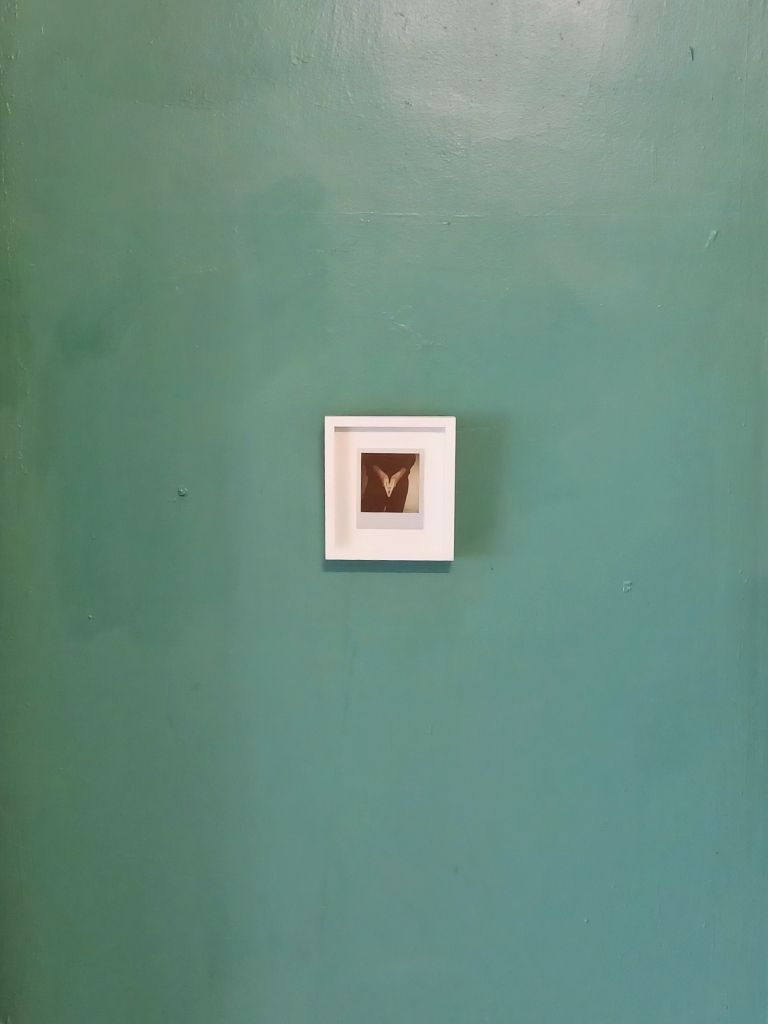
At the heart of the exhibition, every available surface at eye level offers delight. Unbound by its size limitation, the collection presents a satisfying range in scope of perspective, such as an interpretation of a planetary surface captured in Sué – Chibcha by Luis Fernando Suarez, or the speckled night sky in Amateur astronomer by Ben Williamson. Seeking feelings closer to earth, there is the heartwarming simplicity of Softscape by Heather Euloth or the teenage angst that exudes through the watercolour in Canicule – Étude by Mary Hayes.
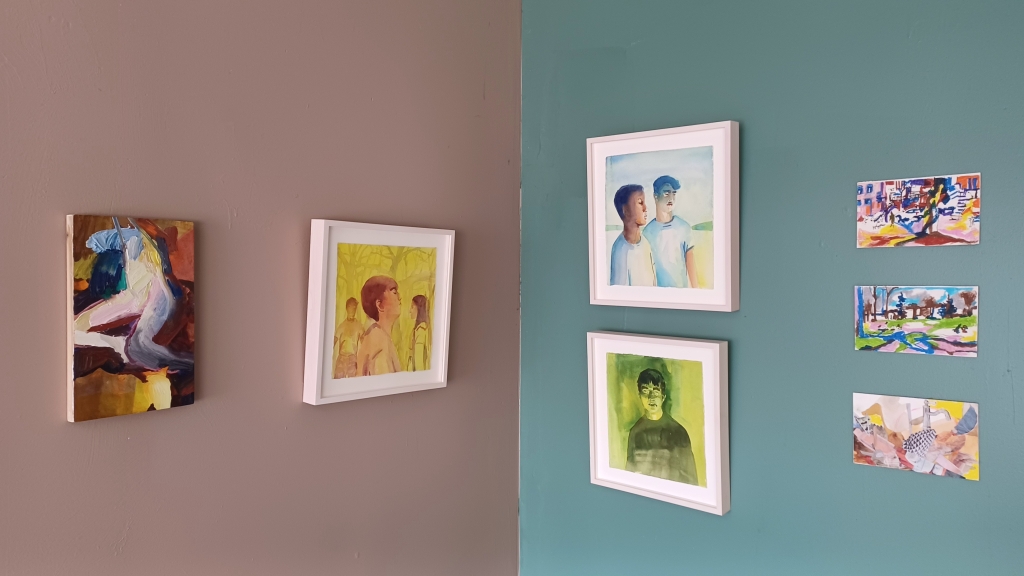
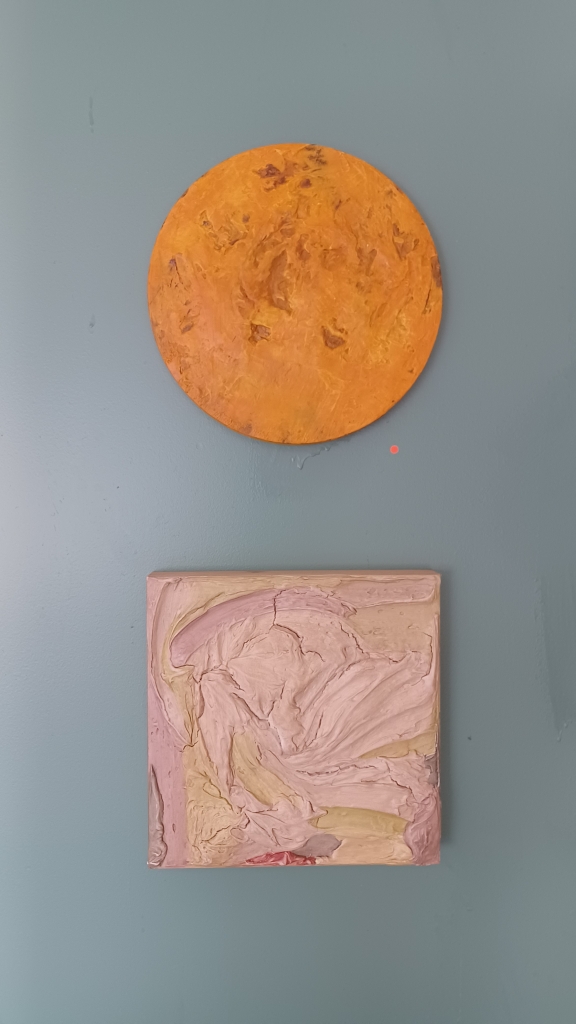
Especially after a long period of isolation brought about by the Covid-19 pandemic, there seems to be a renewed appreciation for the ways in which people might share spaces, as well as a growing need for the revival of communal artistic experiences. To Eckler, there is momentum gathering towards more collective art initiatives, and opening her studio to other artists was a small step towards much bigger things.
“I took over this space at the start of the pandemic, and I was working here during the lockdowns and curfews. When things started to calm down, I felt a shift, where artists were really itching to get out and make things happen,” shared Eckler, “There’s a really strong art community in Montreal. I’ve received a lot from it, so it’s nice to be able to give back and share this beautiful space with others.”
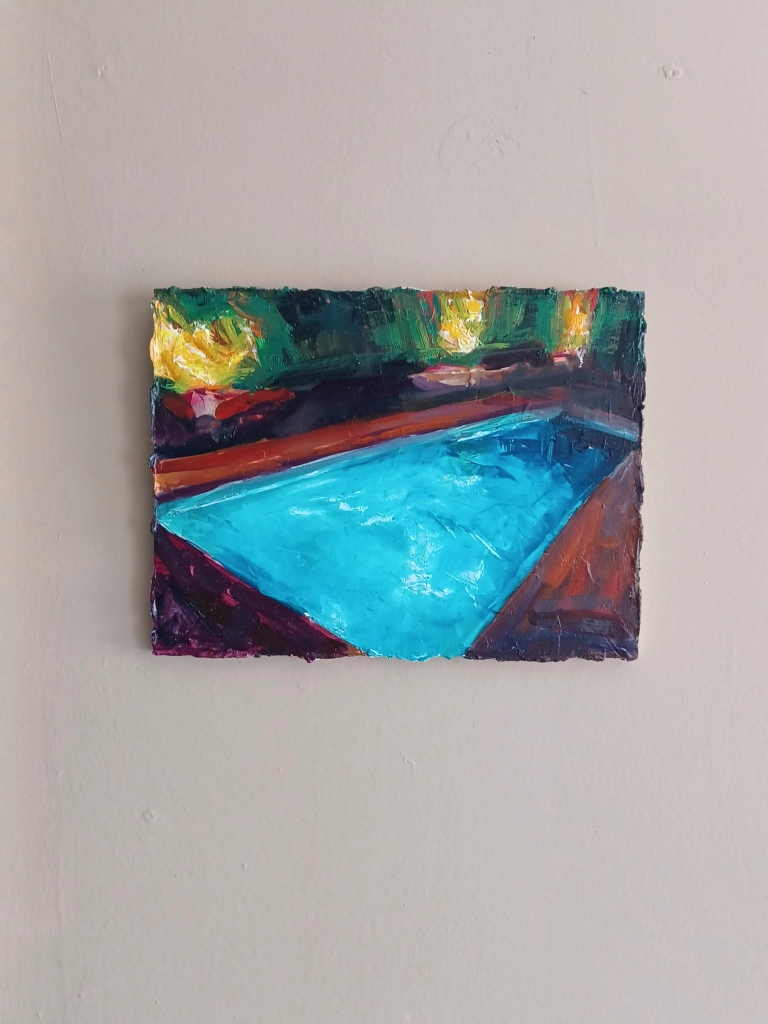
Moving through the gallery, it was easy to forget the limitation of space and focus instead on the abundance of spirit that was gathered there. I ended my visit with Liza Sokolovskaya’s Night Pool, where I stood peering into the depths of an empty inground swimming pool. It is quiet now, undisturbed, but I know that when the sun rises again, it will come alive with all kinds of people splashing around, treading water, their bodies rendered weightless.
Petit et intime runs until May 6 in studio 531.
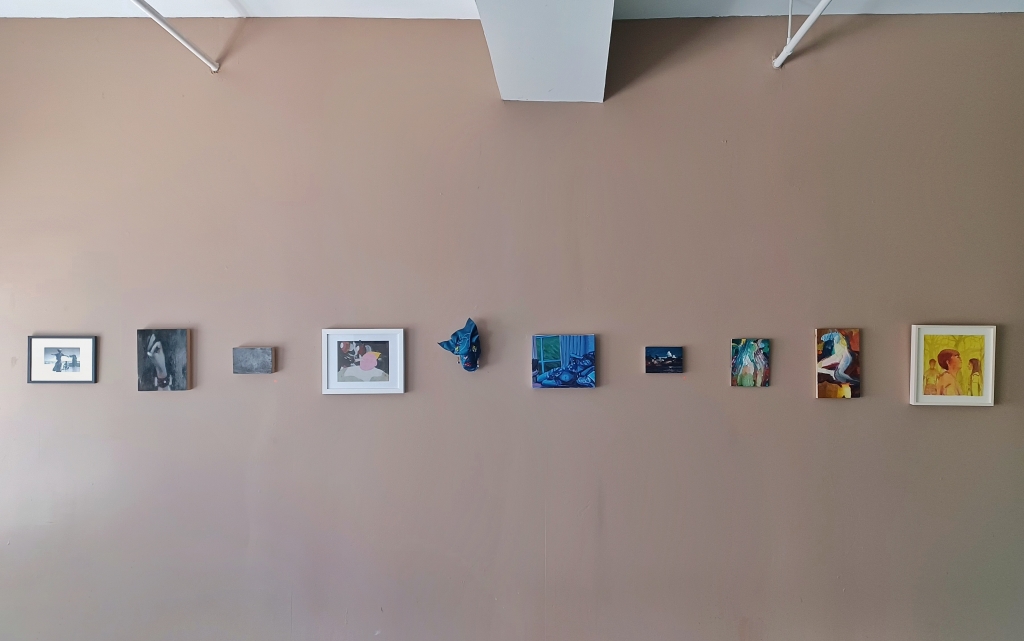
The post Starting Small first appeared on The Belgo Report.
]]>The post Call for Contributors first appeared on The Belgo Report.
]]>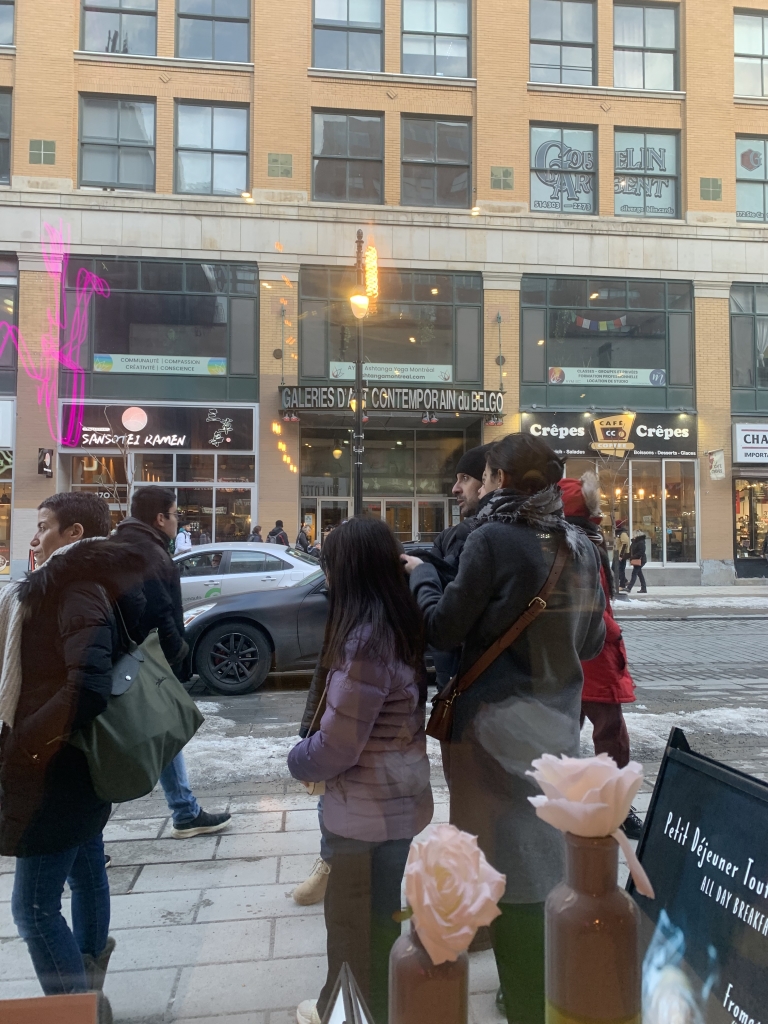
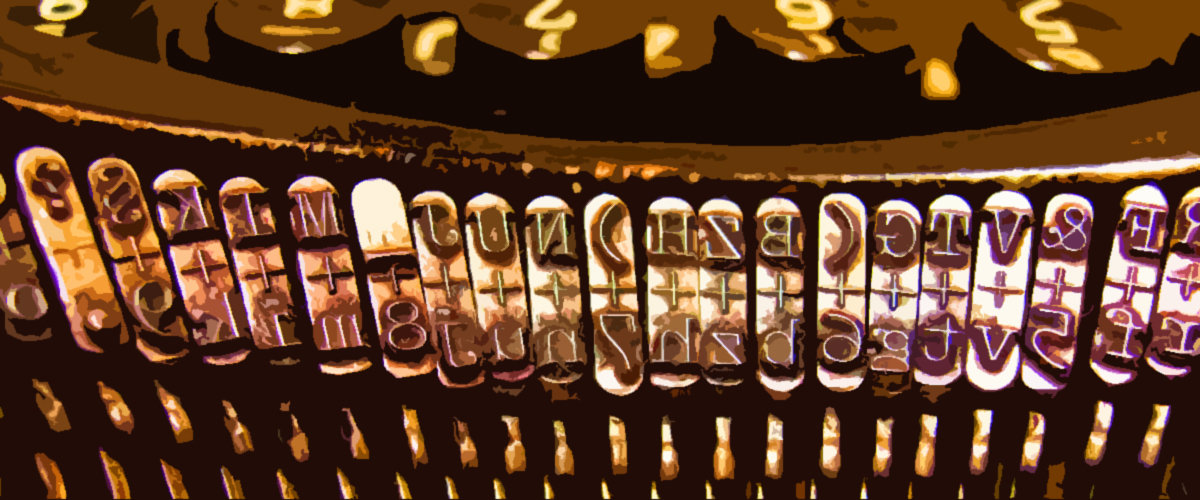
Contribute
The Belgo Report is looking for contributors.
Visual Art Reviewer (English or French)
We are looking for a regular contributor to cover visual art exhibitions and events in the Belgo building. Your articles will appear with your byline and a link back to your own blog. Your headshot and profile will be added to the About the Belgo Report page. If you are interested in becoming part of the Belgo Report team, please send a writing sample to studio@karaeckler.com
The post Call for Contributors first appeared on The Belgo Report.
]]>The post Mia Sandhu: Seeing You, Seeing Me, Seeing You first appeared on The Belgo Report.
]]>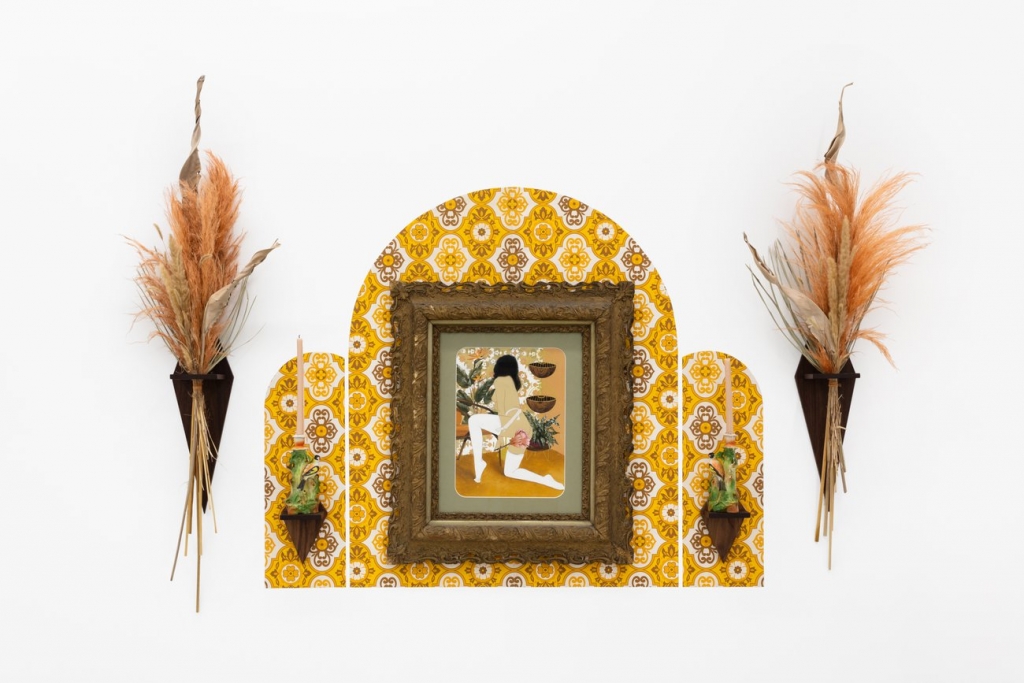
Mia Sandhu is a Punjabi-Canadian artist, born in Canada, currently residing in Toronto. She is an artist who often works with issues of immigration, identity, femininity, and sensuality. Seeing You, Seeing Me, Seeing You was Patel Brown’s second exhibition at their Montreal gallery, and Sandhu’s first solo exhibition in Montreal. These works explore, among other things, the relationship between pleasure and shame. Her figures appear to be at ease with their bodies, confident in their sexuality, at home in their environment and being seen. Perhaps they are so relaxed because some of their most personal physical features, their faces and genitals, are obscured by clouds of black smoke-like veils. The exhibition consists of many works on paper, made with gouache, watercolour, pencil, and charcoal. Paintings on paper are surrounded by vintage furniture (loaned from the personal collection of Patel Brown Montreal gallery director Roxanne Arsenault) and installation elements that create a homey, stylish, and pleasantly kitschy environment for her works. Her inspiration here comes from her collection of vintage erotica, her work as a set painter in the film industry, and her family photos from the seventies, all of which contribute to the aesthetic.
I first discovered Mia Sandhu’s work at the Patel Brown booth at the Papier Art Fair a few years ago in Montreal. I remember her work as exemplary in the use of materials, and striking in her portrayal of the erotic. It was a breath of fresh air at an art fair where senses are overloaded, making a lot of work seem underwhelming. Sandhu’s works on paper stood out and I was delighted to find them again at the fair in the following years. Patel Brown is a welcome new addition to the galleries in the Belgo Building, as an established gallery that is strongly curated, very contemporary, with a brave sensibility that doesn’t shy away from the erotic and the weird, traits which aren’t that common in Canadian art spaces. As a Punjabi-Canadian of mixed cultural identity, and Sandhu’s works have long examined cultural hybridity. Her work often conveys mixed feelings and experiences, dealing with polarities such as shame and self-love, belonging and alienation.
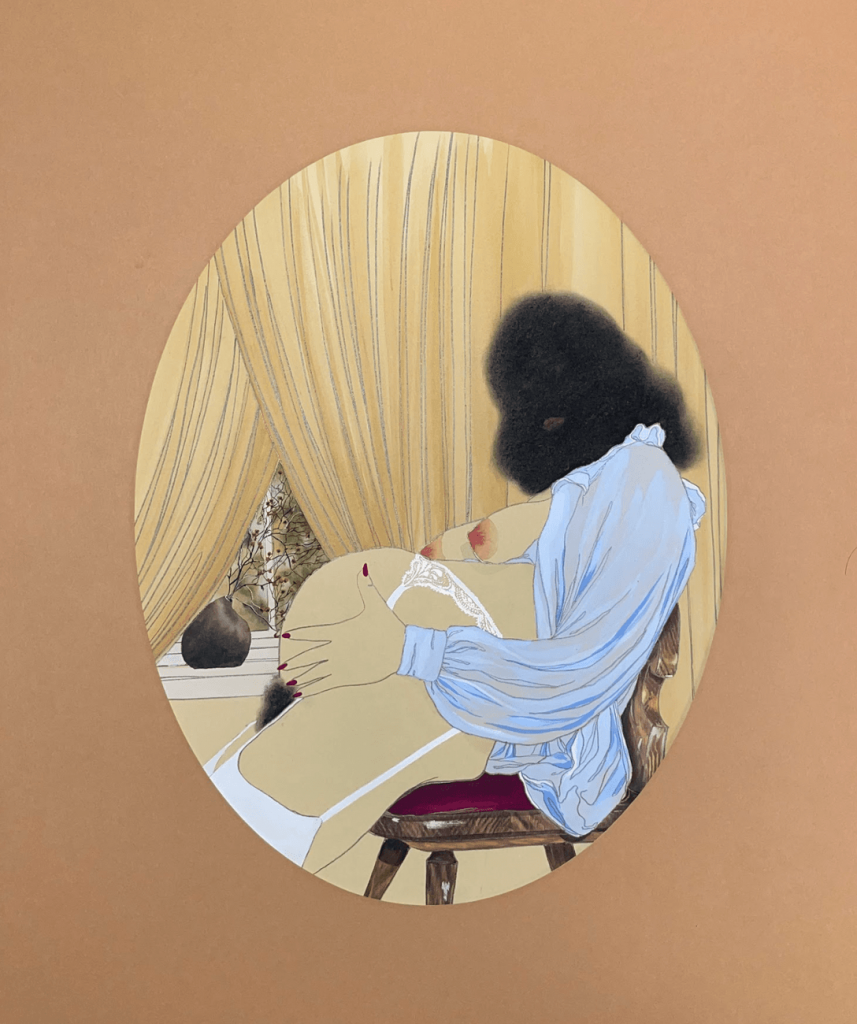
The women in these paintings continue the connection to Sandhu’s last solo show at Patel Brown in Toronto, Golden Girls, except here, the figures are often pregnant, and the overall feel here is more erotic and bizarre. Luxuriating in their own feminine power and grace, bedecked in vintage stockings and heels, sporting full 70s-style bushes, the women seem to be part of a secret sisterhood, perhaps Sapphic, perhaps platonic. They tease us, they enjoy their own existence, and they look at us with the same curiosity with which we regard them. These women see us, the viewer, seeing them. Sandhu’s women are playing up this exchange, legs spread over the arms of a chair, frank gazes meeting ours. These women’s soft, lavish pubic hair mimics the colour and texture of their smoky crowns. Though the smoky veil that enshrouds their visages, these women peer at us with a steady and sometimes flirtatious, sometimes inscrutable regard. There is an erotic exchange of energy in watching and being watched, and these women are disrobed in a way that heightens the eroticism of their bodies and situations. They seem to be fantasy images, yet they are simultaneously beings in and of themselves. Spirits of an idealized 1970s, when free love was the thing and many people had sexual awakenings via breaking down of self or societally imposed sexual mores and conventions.
Many of the women in this series are pregnant, but they seem to be so frankly, ripe with creativity and self-possession. There is no sign of a husband or children around, and the demands of childrearing do not beckon. The sense of the pregnancies in this series seems to be in the way that women are creative goddesses of mystery, rather than possessions intended to extend the tribe and lineage. All of the women who are visibly pregnant in these works seem to be in the last month of their pregnancy, ready to bring new life—new creation—into the world, thereby transforming themselves and the lives of their babies forever. In this way, we are reminded of the artist’s role in bringing new work into the physical realm.
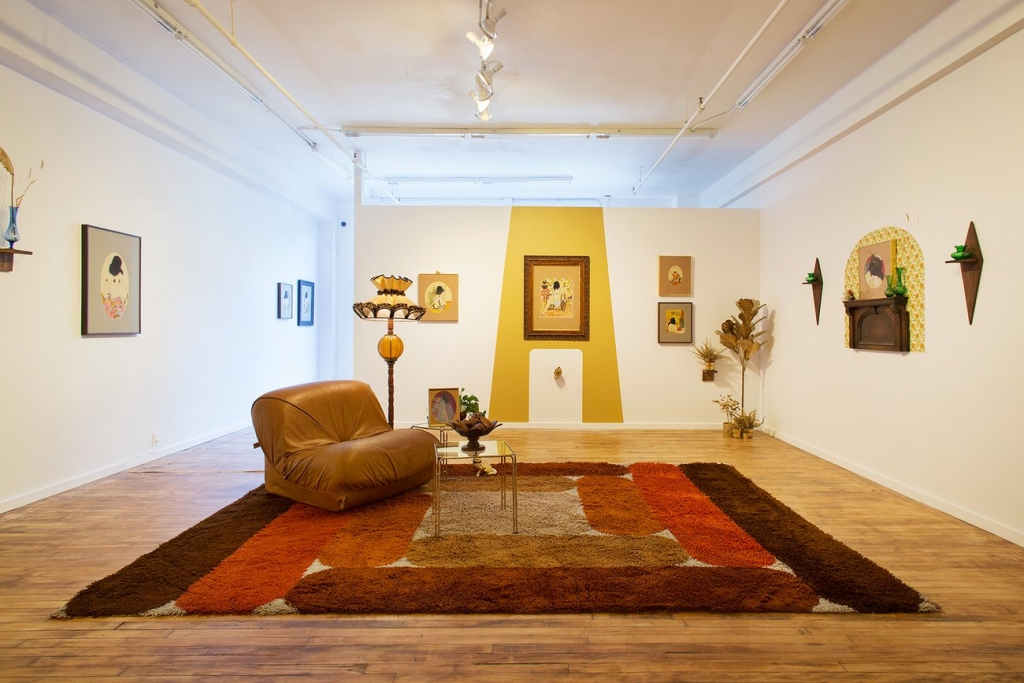
Mia Sandhu has a delicate, skillful touch, a mastery with line that makes one peer closer to admire the skill in the rendering of floral textiles and the details of gorgeous houseplants that surround her figures, enhancing the atmosphere of time and place. There is a pleasant contrast between the opaqueness of gouache with the translucency of watercolour, especially layered here over creamy, warm-coloured paper. I am reminded of the rich history of erotic paintings on paper in Asia, examples of which can be found in humourous Japanese erotica, and often philosophical Chinese paintings, which represent slices of daily life, and the harmony of yin and yang represented in both sexes taking equal pleasure in each other. More importantly is the connection to Sandhu’s own heritage, there is a long tradition of gorgeous erotic paintings on paper in India. Sandhu’s interest in putting her figures in domestic environments, surrounded by bold colour and patterns harkens to the rich history of erotic art in Asia and India, but as a contemporary painter she brings a soft but confident touch, contemporary line and rendering skill, a personal inquiry, and a sense of playful taboo. A woman, especially one raised with an awareness of Eastern culture and mores, would have a keen sense of what is acceptable and not acceptable in terms of sexual expression and modesty. The historical predominance of Christian Anglo-Saxon values on colonial Canada makes this country also not so open to sexual expression, feminine pleasure, or self-possession, feminine sexuality is only acceptable if it is a thing to be consumed and profited from by someone else. Such influences are still quite palpable here today, though of course to a much lesser extent than in the past. I do not doubt that the mixed cultural heritage Sandhu possesses has contributed strongly to her interest in portrayals of concealing and revealing. Probably it the contrast between the two states, the sense of becoming, of transition, that makes these works so compelling.
In A Vessel to Hold 4, a heavily pregnant woman regards herself in the mirror, she seems to be calmly admiring what she sees. The Vessel to Hold paintings speak of the way a mother holds their baby within, and the comforting sensation of being held, and perhaps, to hold one’s own soft, round curves, or that of another. They speak of what it is to nurture and be nurtured, and of the embracing, supportive nature of womanhood and sisterhood. A Vessel to Hold 9, a pregnant woman is attired in a diaphanous blue blouse, her swollen breasts and nipples visible over her large belly, which she holds proudly while regarding us. She seems to ask us to admire what she has made. She sits heavily with physical presence on an antique chair of soft wood and wine-coloured velvet. A Vessel to Hold 10 shows two pregnant nymphs, wearing vintage stockings and lace, luxuriating playfully on a bed lush with blue and white curtains, from which wild Queen Anne’s Lace flowers emerge. Sandhu’s pregnant vixens do not allow for the Madonna and whore duality, they convey the sexy magic of a voluptuous pregnant woman, who can still be desired and desire even though she is a mother-to-be.
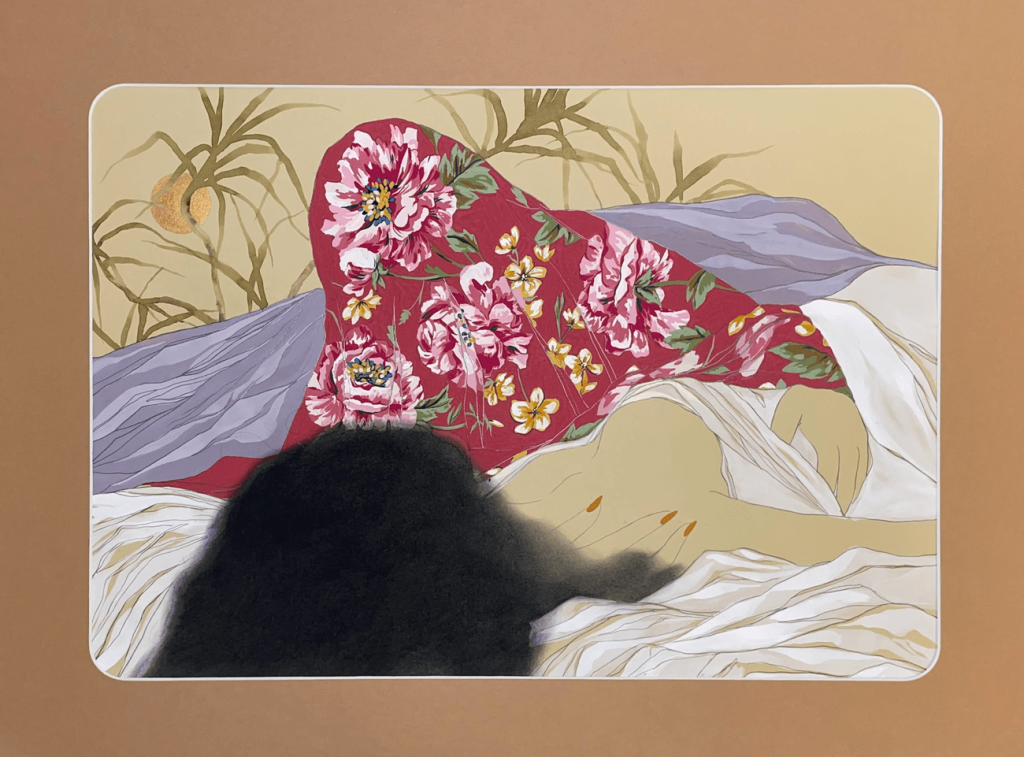
In the Chrysalis paintings, the figures are again covered with thick black smoke, but they are wearing transparent fabric, perhaps gauze. The title of this mini-series implies they are emerging from silken cocoons, resplendent and transformed. In many Eastern countries, influenced by Muslim traditions, women are veiled, but these chrysalises do not conceal, they reveal the glorious transformation of the feminine body, perhaps from childhood to puberty, then maturity, pregnancy, and beyond. In Chrysalis 6, the curvaceous woman kneels on a bed, regarding us with almost frightful self-possession, eyes just points of piercing light through the darkness. She appears before large golden rings, dried flowers, and plants—familiar as installation elements in this exhibition.
In the Waxing and Waning paintings, women disguised by floral shrouds are paired together to play, support, and embrace each other. Waxing and Waning 16 presents a figure concealed by a floral fabric leaning in to caress a reclining woman whose breast is nearly exposed as she receives a red finger-tipped embrace. The black cloud seems to seep like liquid over the bodies and the bed, almost as if it is an extension of the fluid energy of the couple. Sexual symbolism is apparent in Pussy Willows and Cat Tails, we see the “tail” of the figure, clad in a thong. The bullrushes, or cat tails, look phallic, paired with the delicate toes of the pussy willow branches.
A play on words, and with a nod to popular culture, the bodies in Mia Sandhu’s Bawdy paintings could be considered raucously, joyously nude and lewd. They’re playing in decidedly kitschy 70s environments, enjoying their physical forms and showing off. Full, heavy breasts, costume jewelry, furry armpits, and more greet us. The woman in Bawdy 37 has a leg thrown over the arm of a wicker chair, revealing white panties. She is holding an apple, like Eve, yet shameless. This work is intriguingly presented on a wooden shelf, flanked by retro decorative elements, against a white and mustard-coloured floral patterned wallpaper, almost as a shrine. This style is reflected in Bawdy 36, where a white opaque-stockinged nymph coquettishly draws a stemmed flower between her legs as she kneels on the floor before a chair and houseplants. The painting is flanked by campy candle holders against a different type of vintage-style wallpaper. These works by Sandhu create a scene that reminds us to gracefully, playfully enjoy while asking ourselves: what is the nature of self, embodiment, and pleasure?
The signature black smoke around the women in Seeing You, Seeing Me, Seeing You, is like a dark nimbus, light but thick, allowing us to see curious, sensual eyes through the clouds. The black veils are almost afro-like, echoing the dense bush between their legs which obscures and mystifies their vulvas. The nipples and areoles are lovingly rendered, with great attention to variations of colour and texture which make them remarkably lifelike. Sandhu’s women are queens, Goddesses, courtesans, porn actresses, mothers— archetypes of luxury, physical and emotional nurturing, and sensuality. Their veils obscure their identity, cloak them in anonymity, beyond reproach or identification, rendering them archetypal. They play, exploring the connection to the other, to the world, within self-designated realms of boundary and safety. exposed and concealed.
Instagram: @patelbrown @mia.sandhu
Photo credit: Kyle Tryhorn @gingerhorn
The post Mia Sandhu: Seeing You, Seeing Me, Seeing You first appeared on The Belgo Report.
]]>